Eat, Sleep, Wander

20+ Student Biography Examples
Welcome to the world of students! We have created an amazing collection of 30 student biography examples to help you write your own.
As a student, you are likely to be writing a variety of biographical pieces. Whether you are writing a personal profile for your CV, a biography for an awards application or a biography for a college admissions essay, it’s important that you construct an interesting and engaging narrative of who you are.

Student Biography Examples
1. Growing up I was always interested in the sciences and technology. In high school, I excelled in math and science classes, which led me to pursue a degree in engineering. I went on to earn my Bachelor’s degree in Engineering and am currently working on my Master’s in Civil Engineering. After I finish my degree, I plan to use my knowledge to help improve infrastructure in developing countries.
2. Since a young age, I have been passionate about helping people in need. During college, I decided to focus my studies on sociology and political science. I used my knowledge to take action and participated in several non-profit organizations to promote social justice. With the help of internships, I have also gained experience in policy development and public relations. I’m currently working on a graduate degree in Social Work and aim to eventually work for the United Nations .
3. As a freshman in high school, I was unsure of what kind of career path I wanted to pursue. After talking with my parents and teachers, I decided to start college as an undeclared major. After two years of exploration, I settled on a double major of business and economics. I’ve been able to take advantage of various opportunities on and off campus and served as an intern in the Human Resources department of a major banking firm. I look forward to earning my degree and using my skills to become a successful business leader.
4. I never thought that I had the ability to become a professional photographer, but my high school photography teacher pushed me to pursue my dreams. I learned how to use a variety of cameras, develop photographs, and post-process my images. I continued my photography studies at college, where I gained additional knowledge in studio lighting and digital editing. I was even able to gain experience in the fashion industry, interning for a well-known photographer . Today, I am working as an event photographer, documenting weddings, reunions, and corporate events.
5. When I was younger I was passionate about art, which prompted me to pursue a bachelor’s degree in Fine Arts. During college, I was able to gain experience as a studio assistant and also learn various digital and traditional art techniques. With the help of a scholarship, I was able to travel to various countries and learn even more about different art styles. After graduation, I started working as a freelance artist and have been able to produce several commissioned artworks and pieces.
6. As a child, I always exhibited an aptitude for mathematics and problem solving. After researching various career paths, I decided to major in Computer Science. I was able to gain valuable experience while interning at a tech startup and also during an internship with the Department of Defense. I am currently working on my master’s degree and plan to focus my studies on artificial intelligence and machine learning.
7. I have been involved in theater since I was a young child. During my high school years, I focused on honing my abilities through various extracurricular activities. I was able to gain valuable experience by participating in multiple productions and I even gained a scholarship for theater. I attended college to study Musical Theater and continued to foster my talent. With help from internships and workshops, I was able to build additional experience and formed a touring theater company with some of my colleagues.
8. From an early age, I was interested in the environment and the outdoors. I spent a lot of time reading environmental books and researching environmental issues. This passion inspired me to major in Environmental Science in college. I’ve gained valuable experience through various internships and part-time jobs. With the help of my degree, I’ve been able to work on several conservation projects and hope to soon work for a non-profit organization focused on sustainability.
9. When I graduated high school I wanted to focus my career on the medical field. After much research, I decided to major in Biomedical Engineering. During my time in college, I was able to gain a valuable experience by interning as a research assistant. I have been able to learn more about medical technology and have been able to contribute to various projects. I’m currently pursuing a master’s degree in Biomedical Engineering and plan to continue my research in the field and eventually work for a healthcare company.
10. I have always had an interest in fashion and design, so when the time came to decide my career path it made sense to pursue design. During college, I was able to study many aspects of fashion and gain experience through various internships. I was also able to travel to other countries to observe trends and learn about different cultures. With my degree, I am currently working as a fashion designer and I plan to continue to use my creative eye to come up with innovative and stylish designs.
More Student Biography Examples on the next page…

Biography Samples For Students: How To Write A Perfect One?
July 23, 2023
Navigating through the academic world, students often find themselves in situations where they need to present a concise yet impactful biography. Whether it’s for a scholarship application, a college admission essay, or a professional networking platform, a well-crafted student biography can open doors to opportunities. In this guide, we’ll explore some biography samples for students and provide you with tips to write one for yourself.
What Is A Student Biography?
A student biography is a concise written account that provides an overview of a student’s academic background, achievements, extracurricular activities, and career aspirations.
It serves as a tool for introducing oneself to teachers, peers, scholarship committees, college admissions officers, or potential employers.
Student biographies are often required for various purposes, such as college applications, scholarship applications, internship opportunities, and networking profiles.
Why Student Biographies Matter
A student biography serves as a snapshot of your academic journey, achievements, and aspirations. It allows you to introduce yourself to others in a way that goes beyond grades and test scores, providing a personal touch that can make a lasting impression on educators, peers, and potential mentors.

Elements of a Standout Student Biography
1. Academic Background: Share information about your current academic pursuits, including your major, classes, and any notable achievements or projects.
2. Extracurricular Activities: Highlight your involvement in clubs, sports, volunteer work, or any other activities outside of the classroom. This demonstrates a well-rounded personality and showcases your interests.
3. Achievements and Awards: Mention any academic awards, scholarships, or honors you’ve received. This helps validate your dedication and excellence in your studies.
4. Career Aspirations: Discuss your future goals and career aspirations. This could include the field you want to enter, specific job roles, or how you envision making a positive impact.
5. Personal Touch (Optional): If appropriate for the context, consider adding a personal touch by mentioning hobbies, interests, or aspects of your life outside of academics. This can humanize your biography and make it more memorable.
Sample Student Biographies
Example 1: science enthusiast.
Hello, I’m [Your Name], a sophomore majoring in Physics at [Your University]. My passion for unraveling the mysteries of the universe extends beyond the classroom. As an active member of the Science Club, I’ve had the opportunity to collaborate on research projects, including [Brief Project Description].
My goal is to pursue a Ph.D. in Astrophysics, combining my love for research with a commitment to advancing our understanding of the cosmos.
Example 2: Social Justice Advocate
Greetings! I’m [Your Name], a dedicated student pursuing a degree in Sociology at [Your College]. Beyond academics, I am deeply involved in community service initiatives, such as [Volunteer Work]. My aim is to leverage my education to promote social justice and equality.
Inspired by [Influential Figure], I aspire to contribute to building a more inclusive and equitable society.
Example 3: Future Business Leader
Hi there! I’m [Your Name], a junior majoring in Business Administration at [Your School]. My academic journey has been complemented by my role as the president of the Business Club, where I’ve organized successful networking events like [Event Name].
My ambition is to leverage my entrepreneurial skills to innovate within the business world and make a positive impact on local communities.
Need More Examples?

Here are two more examples of student biographies tailored for different purposes:
Example A: College Application
Hello! I’m [Your Name], a high school senior eagerly anticipating the next chapter of my academic journey. Currently pursuing a rigorous course load with a focus on STEM subjects, I have developed a passion for physics and mathematics. As an active member of the Science Club, I’ve had the privilege of leading a team in the regional science fair, where our project on renewable energy solutions earned first place.
Beyond academics, I am deeply involved in community service through my role as a volunteer at [Local Organization]. This experience has not only broadened my perspective but also reinforced my commitment to making a positive impact. My academic achievements, including being named a National Merit Scholar, reflect my dedication to excellence.
Looking ahead, I aspire to major in Physics and continue exploring sustainable solutions to global challenges. My goal is to contribute to scientific advancements that address environmental issues. I am excited about the prospect of joining [University Name] and engaging with a community that shares my passion for knowledge and innovation.
Example B: Scholarship Application
Greetings! I am [Your Name], a junior majoring in Business Administration at [Your University]. My academic journey has been complemented by my active involvement in the Business Club, where I currently serve as the vice president. Through organizing networking events and workshops, I’ve developed leadership and organizational skills that I believe are essential for success in the business world.
My dedication to academic excellence has been recognized with the Dean’s List distinction for three consecutive semesters. Additionally, I am the recipient of the [Scholarship Name], an honor that has significantly eased the financial burden of pursuing higher education.
Looking forward, I am determined to leverage my education and experiences to contribute to the business field. My long-term goal is to establish a socially responsible business that fosters innovation and positively impacts local communities. Receiving the [Scholarship Name] would not only support my academic journey but also empower me to pursue these aspirations with greater focus and determination.
These examples demonstrate how a student biography can be tailored for different purposes, such as a college application or a scholarship application. They include information about academic pursuits, extracurricular involvement, achievements, and future aspirations, providing a comprehensive overview of the student’s profile.
Conclusion on biography samples for students
Crafting a compelling student biography is an invaluable skill that goes beyond academic settings. Whether you’re applying for scholarships, internships, or simply introducing yourself to your peers, a well-crafted biography can open doors and create connections.
Use these samples as inspiration, and remember to infuse your unique personality and aspirations into your own narrative. Your student biography is your story—make it memorable!
2 thoughts on “Biography Samples For Students: How To Write A Perfect One?”
Great! I just got an A for my bio project at school thanks to your advice here
@Alice: Dear Alice, we are so glad to hear so. All best wishes!
Leave a Comment Cancel reply
Save my name, email, and website in this browser for the next time I comment.

285/110 Cach Mang Thang Tam, HCMC, Vietnam 70000
+1(646)760-6211 [email protected]
Brand Information
Get A Bio (LSM) - Business Registration No: 0316830818
Get A Bio is owned by LSM Group and professionally managed by Zesno , a digital marketing firm.
Biography Examples for Students: A Helpful Guide
Crafting a biography as a student can be a daunting task, requiring a delicate balance between sharing personal information and maintaining a professional tone. In this comprehensive guide, students will find a wealth of biography examples to serve as inspiration and guidance in developing their own unique narratives.
From academic achievements to extracurricular activities, a well-rounded student biography can showcase a student's skills and aspirations effectively. Examples of student biographies can provide valuable insights into the structure , tone , and content expected, offering a roadmap for creating a compelling self-portrait.
Whether for a school project, a college application, or a personal portfolio, having access to well-crafted biography examples can be instrumental in empowering students to present themselves authentically and persuasively. By studying different approaches and styles in these examples, students can tailor their biographies to resonate with their intended audience and achieve their desired objectives.## Top 10 Biography Examples for Students
Biographies offer insight into the lives of remarkable individuals, serving as a source of inspiration for students. Here are 10 remarkable biography examples that can captivate and motivate students:
The Diary of a Young Girl by Anne Frank - Provides a poignant account of a young girl's experiences during the Holocaust.
Steve Jobs by Walter Isaacson - Chronicles the visionary journey of Apple's co-founder, showcasing his creativity and innovation.
I Am Malala by Malala Yousafzai - Tells the courageous story of a young advocate for girls' education and her fight against Taliban oppression.
The Story of My Life by Helen Keller - Inspires with the incredible tale of overcoming deaf-blindness to become a renowned author and activist.
Long Walk to Freedom by Nelson Mandela - Portrays the struggles and triumphs of the South African leader in the fight against apartheid.
Anne Frank: The Diary of a Young Girl - Offers a first-hand account of a Jewish girl's life during World War II.
Malala: My Story of Standing Up for Girls' Rights - Chronicles Malala Yousafzai's advocacy for education and the challenges she faced.
Albert Einstein: His Life and Universe - Explores the life and achievements of the renowned physicist, shedding light on his groundbreaking theories.
Steve Jobs: The Man Who Thought Different - Provides insights into the visionary mind of the Apple co-founder and his impact on technology.
Becoming by Michelle Obama - Delves into the life of the former First Lady of the United States, sharing her journey from a girl in Chicago to a global icon.
These biography examples offer a diverse range of experiences and achievements, making them valuable sources of learning and inspiration for students seeking to understand the lives of exceptional individuals.
Key Components to Include in a Student Biography
When crafting a student biography, key components should be carefully considered to paint a clear picture of the individual's background, achievements, and aspirations. Here are essential elements to include in a comprehensive student biography:
Introduction : Begin with the student's name and introduce who they are in a concise and engaging manner.
Background : Provide details about the student's background, such as their hometown, family, and any influential experiences that have shaped their journey.
Education : Highlight the student's academic pursuits, including their current education level, major or focus of study, academic achievements, and extracurricular activities related to their educational path.
Achievements : Showcase any notable accomplishments, awards, scholarships, or projects the student has undertaken to demonstrate their skills and dedication.
Skills and Interests : List the student's skills and hobbies, showcasing a well-rounded profile beyond academics. This can include languages spoken, technical abilities, artistic talents, or sports interests.
Career Goals : Discuss the student's career aspirations and goals, emphasizing their ambitions for the future and how their current endeavors align with their long-term plans.
Passions and Values : Share insights into the student's passions, beliefs, and values, offering a glimpse into their personality and what drives them.
Overall, a student biography serves as a powerful tool to present a well-rounded view of the individual, showcasing their unique qualities, accomplishments, and aspirations. By including these key components, a student can effectively communicate their story and make a lasting impression on readers.
How to Make a Student Biography Stand Out
When crafting a student biography, it's essential to highlight unique experiences and achievements that set you apart from the crowd. By following these tips, you can create a compelling biography that grabs attention:
1. Start with a Strong Opening
- Capture the reader's interest from the very beginning with a captivating opening sentence.
- Consider starting with a personal anecdote or a powerful quote to make a memorable impression.
2. Showcase Key Achievements and Skills
- Highlight academic accomplishments, extracurricular activities, and any relevant work experience.
3. Keep It Concise and Relevant
- Focus on key details that showcase your personality, interests, and goals.
- Aim to keep the biography brief and to the point , emphasizing quality over quantity.
4. Inject Some Personality
- Let your unique voice shine through in your writing to make your biography more engaging.
- Avoid using clichés and instead opt for authentic and original descriptions.
5. Include Future Aspirations
- Share your academic and career goals to give the reader insight into your ambitions.
- Express your enthusiasm for your chosen field of study or future profession.
6. Proofread and Edit
- Ensure your biography is free of spelling and grammar errors to convey professionalism.
- Consider asking a teacher or mentor to review your biography for feedback and suggestions .
By following these guidelines, students can create a compelling and memorable biography that effectively showcases their unique qualities and aspirations. Remember, a well-crafted student biography can be a powerful tool in leaving a lasting impression on peers, educators, and potential employers.
Inspirational Student Biography Samples
Writing a student biography can be challenging , but having some inspirational samples to refer to can provide guidance and encouragement . Here are a few student biography examples that showcase different strengths and achievements :
Sarah Johnson : She is a 15-year-old student who excelled in both academics and athletics . Despite facing personal challenges , she maintained a positive attitude and dedication towards her studies and sports .
Alex Martinez : A creative student with a passion for art and design . His innovative approach to projects earned him recognition at local art exhibitions and school competitions .
Emily Wong : An aspiring scientist who conducted a research project on environmental conservation . Her findings were published in a scientific journal and she was invited to present at a national conference .
These biography examples emphasize the unique talents and determination of each student, serving as inspiration for others looking to craft their own story . By showcasing diverse experiences and accomplishments , these student biographies highlight the importance of resilience , passion , and hard work in pursuit of academic and personal goals .
In conclusion, students can draw motivation and insight from these biography samples to shape their own narrative and strive for success in their educational journey .
Utilizing Student Bio Templates Effectively
When it comes to crafting a compelling student bio, using templates can be a game-changer. Student bio templates provide a structured format that helps students showcase their achievements, skills, and personality in a clear and concise manner. Here are some effective ways to make the most out of student bio templates:
Organization is Key
- Use section headers to divide the bio into key areas such as education, experience, skills, and interests.
- Arrange information in a logical order to make it easy for readers to navigate.
Customize to Stand Out
- Personalize the template by adding unique details that reflect the student's individuality.
- Highlight achievements and awards to grab the reader's attention.
Keep it Concise
- Avoid lengthy paragraphs and aim for succinct sentences that convey information efficiently.
- Focus on relevance by including details that align with the purpose of the bio.
Maintain Professionalism
- Use a formal tone and professional language to create a polished impression.
- Proofread the bio carefully to eliminate any spelling or grammatical errors.
Utilize Formatting Tools
- Bold important information to make it stand out.
- Utilize bullet points for listing skills, achievements, and interests in a clear and organized manner.
By following these guidelines, students can effectively utilize bio templates to create impactful narratives that resonate with their audience.Remember, the key is to tailor the template to reflect the individuality and achievements of the student, making their bio a compelling read for any reader.
Crafting a Compelling Personal Bio
Crafting a compelling personal bio is crucial for students aiming to make a lasting impression. Here are some key tips to help students create a professional and engaging biography:
Start with a Strong Introduction : Begin the bio with a captivating opening sentence that highlights the individual's unique qualities or accomplishments.
Highlight Key Achievements : Showcase notable achievements, skills, and experiences that set the student apart from others. Keep it concise but impactful.
Include Personal Interests : Adding a personal touch by mentioning hobbies or interests can make the bio more relatable and memorable.
Maintain a Professional Tone : Ensure the bio remains professional in tone and language, reflecting the student's maturity and readiness for future opportunities.
Use Keywords Strategically : Incorporate relevant keywords related to the student's field of study or interests to enhance search visibility and attract the right audience.
End with a Call to Action : Conclude the bio with a clear call to action, such as inviting readers to connect on professional platforms or learn more about the student's work.
In a world where first impressions matter, a well-crafted personal bio can leave a lasting impact on educators, peers, and potential employers. By following these guidelines and infusing personality into their bios, students can effectively showcase their unique qualities and accomplishments with confidence and professionalism.
Dos and Don'ts for Writing Student Biographies
When it comes to crafting engaging student biographies, there are specific Dos and Don'ts that can make a significant difference in the quality and effectiveness of the final piece. Here are some essential tips to keep in mind:
- Do Include Relevant Information: Focus on including information that is relevant to the purpose of the biography. Highlight academic achievements, extracurricular activities, and personal interests that showcase the student's unique personality.
- Do Use a Professional Tone: Maintain a professional tone throughout the biography. Use clear and concise language to convey the student's accomplishments and aspirations effectively.
Don'ts:
- Don't Include Irrelevant Details: Avoid including irrelevant or unnecessary details that do not contribute to the overall narrative of the biography. Stay focused on highlighting key achievements and experiences.
- Don't Exaggerate Accomplishments: While it's essential to showcase accomplishments, it's crucial not to exaggerate or falsify information. Stick to the facts and present them in a compelling manner.
Remember, a well-crafted student biography can make a lasting impression on readers, whether they are potential employers, college admissions officers, or scholarship committees. By following these Dos and Don'ts, students can create compelling biographies that effectively showcase their strengths and aspirations in a concise and professional manner.
Student Biography Mistakes to Avoid
When crafting a student biography, avoiding common mistakes is crucial to creating a compelling and professional narrative. Here are some key mistakes to steer clear of :
Overloading with irrelevant details : Students should focus on relevant information that highlights their accomplishments and aspirations. Avoid including excessive personal details that do not add value to the biography.
Exaggerating achievements : While it's important to showcase accomplishments, inflating or misrepresenting achievements can damage credibility. It's essential to be truthful and authentic in the biography.
Neglecting proofreading : Grammatical errors or typos can detract from the overall quality of a student biography. Proofreading is crucial to ensure that the biography is polished and error-free.
Lacking storytelling elements : A compelling narrative can captivate readers and make the biography more engaging. Students should weave a story that showcases their journey, challenges overcome, and goals for the future.
Ignoring the target audience : Students should tailor their biography to suit the intended audience . Whether it's a college application, internship opportunity, or networking event, the biography should be relevant and appealing to the specific audience.
Being overly formal or informal : Finding the right tone is essential. A student biography should strike a balance between professionalism and personality to leave a lasting impression.
In a competitive academic and professional landscape, avoiding these common mistakes can help students stand out and leave a positive impact with their biography. By crafting a well-written and engaging narrative that highlights their achievements and aspirations authentically, students can create a compelling biography that sets them apart.
Showcasing Achievements in a Student Biography
When it comes to showcasing achievements in a student biography, clarity and conciseness are key. By effectively highlighting accomplishments, a student can leave a lasting impression on readers. Here are some valuable tips to craft this section effectively:
1. Prioritize Relevant Achievements : Focus on achievements that are relevant to the student's goals or the context in which the biography will be presented. Highlight academic accomplishments, leadership roles, extracurricular activities, and community involvement.
2. Quantify Accomplishments : Where possible, quantify achievements with specific numbers or data. For instance, mention being in the top percentile of a class, winning a certain number of awards, or leading a successful project that resulted in a measurable outcome.
3. Use Bullet Points : Organize achievements in a clear and structured manner using bullet points. This format makes it easy for readers to scan through and grasp the student's key accomplishments quickly.
4. Include Testimonials or Recognition : If the student has received any testimonials, awards, or special recognition for their achievements, be sure to include them. Testimonials add credibility and provide a third-party perspective on the student's abilities.
5. Highlight Growth and Development : Apart from academic or extracurricular achievements, consider showcasing instances where the student demonstrated personal growth or overcame challenges. This humanizes the biography and adds depth to the student's narrative.
In summary, the Showcasing Achievements section of a student biography is a critical component that allows the reader to gain a comprehensive understanding of the student's capabilities and accomplishments. By presenting achievements in a structured, quantifiable, and relevant manner, the student can make a strong, memorable impression on those who read their biography.
Conclusion: Mastering the Art of Student Biographies
Crafting a captivating student biography is a skill that can open numerous doors for young individuals. By implementing the strategies and examples outlined in this guide, one can compose a compelling narrative that showcases their achievements, aspirations, and unique qualities. Here are some key takeaways to help you master the art of writing a captivating student biography:
Highlight Accomplishments : Emphasize academic achievements, extracurricular activities, and any notable awards or honors.
Showcase Personality : Share personal interests, hobbies, and values to give readers a glimpse into who you are beyond academics.
Structure Matters : Organize your biographical details in a clear and coherent manner, starting with a brief introduction and moving on to key points in a logical sequence.
Tailor to Audience : Consider the purpose of your biography and adapt the content accordingly, whether it's for a college application, internship, or personal website.
Edit and Proofread : Ensure your biography is free of grammatical errors, typos, and inconsistencies by thoroughly reviewing and revising the content.
By following these guidelines, students can create impactful biographies that make a lasting impression on readers. Remember, your student biography is an opportunity to tell your story and illustrate your potential to those who come across it. Mastering this art can be a valuable skill that sets you apart in various academic and professional settings. Embrace the process of self-reflection and storytelling to create a biography that truly represents who you are and what you aspire to achieve.
More Articles
Sites like grammarly: best alternatives for grammar and spell checking.
Looking for alternatives to Grammarly for enhanced grammar and spell checking ? A diverse range of writing tools are available to meet varying preferences and needs. These platforms offer similar functionalities to Grammarly while providing...
Outline Maker: Simplify Your Writing Process
An Outline Maker is a valuable tool for writers looking to streamline their writing process. Whether you are a seasoned author, a student working on an essay, or a professional preparing a report, an outline can significantly enhance the organ...
How Long Does It Take to Write a Press Release: A Time Analysis
Writing a press release is a crucial step for businesses and organizations to effectively communicate their news and announcements to the media and the public. A well-crafted press release can generate media coverage, increase brand visibility, an...
Battle Cards Sales: Boost Your Business with Strategic Marketing Tools
Battle cards are a powerful tool in the world of sales and marketing, helping businesses gain a competitive advantage by equipping their sales teams with strategic information and insights. These succinct, visually appealing documents provide key ...
Creative Names for Newsletter: Unleash Your Imagination with These Catchy Ideas
Newsletter names play a crucial role in catching readers' attention and fostering engagement. A creative and catchy name can make a newsletter stand out from the crowd, increasing the chances of it being read and shared. Unleashing one's imaginati...
Canva-Like Websites: Top Online Design Tools for DIY Projects
Canva-like websites have revolutionized the way individuals approach do-it-yourself (DIY) design projects by offering intuitive platforms that empower users to create professional-looking graphics with ease. These online design tools cater to a wi...
Write Blog Posts In Seconds Using AI ✨
Popular Topics
- the optimal length for instagram caption
- sentences in a paragraph
- press release writing for an event
- press release template
- press release generator
- press release creator
- perfect paragraph writing
- paragraph sentence
- paragraph generator
Trending Now View All

Maika AI Officially Ceases Operations on the Web Platform on November 18, 2024
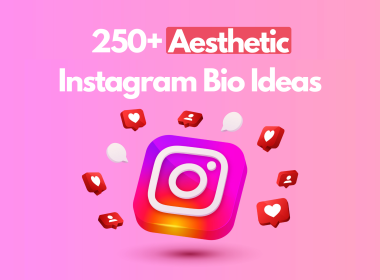
Aesthetic Instagram Bio Ideas: Stand Out with Creative and Catchy Bios

How to Write a Student Bio About Yourself?

10+ AI Professional Bio Generators You Must Try in 2024
- Content Handbook
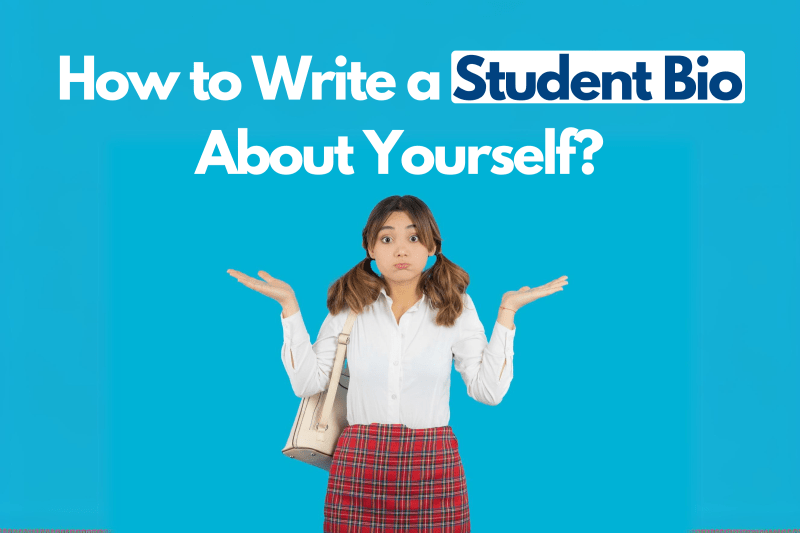
A student bio is a short introduction about yourself that is commonly used in academic settings. It is a way for students to showcase their achievements, goals, and personal qualities. Writing an effective student bio can be a daunting task, but with the right approach, you can create a compelling bio that will leave a lasting impression. In this article, we will discuss why a student bio is important, what to include in a student bio, provide some student bio examples, and share tips for writing an effective student bio.
1. Why is a Student Bio Important?
A student bio is important for several reasons. First, it provides others with a quick snapshot of who you are as a student and what you have accomplished. It allows others to get to know you on a more personal level and can help to establish connections and build relationships.
Second, a student bio can be used as a tool for self-promotion. It gives you the opportunity to highlight your strengths, skills, and experiences. This can be particularly helpful when applying for scholarships, internships, or jobs.
Finally, a student bio can be a useful networking tool. By sharing your bio with others, you can increase your visibility and attract opportunities that may not have otherwise been available to you.
2. What to Include in a Student Bio?

When writing a student bio, it’s important to include relevant information that showcases your accomplishments, goals, and personal qualities. Here are some key elements to consider including:
2.1. Introduction
Start your student bio with a brief introduction about yourself. This should include your name, your current educational institution, and your field of study or major.
2.2. Academic Achievements
Highlight any academic achievements or honors you have received. This can include things like being on the honor roll, receiving scholarships, or being recognized for your academic performance.
2.3. Extracurricular Activities
Include any extracurricular activities or organizations you are involved in. This can include clubs, sports teams, volunteer work, or leadership roles.
2.4. Work Experience
If you have any relevant work experience, include this in your student bio. This can be internships, part-time jobs, or any other work experience that is relevant to your field of study or career goals.
2.5. Goals and Aspirations
Share your goals and aspirations for the future. This can include your career goals, plans for further education, or any other goals you have set for yourself.
2.6. Personal Qualities
Highlight any personal qualities or characteristics that set you apart. This can include things like being a team player, having strong leadership skills, or being detail-oriented.
3. Student Bio Examples
Here are some biography examples for students that showcase different formats and styles:
3.1. College Student Bio
If you don’t know how to start a biography, the examples below may help.
3.1.1. College Student Bio example about yourself in formal style
Follow these examples to write a professional biography for students.
“Greetings, I am Sarah Chang, a junior enrolled in the Computer Science program at ABC University. My academic pursuits are centered around the intricate field of computer science, where I dedicate my time to unraveling complex problems and advancing technological solutions. Beyond the classroom, I actively participate in the Women in Tech club, advocating for gender diversity and inclusivity within the technology sector. Additionally, I am an enthusiast of gastronomy, indulging in culinary explorations to broaden my palate and cultural awareness. My professional aspirations entail securing a position within a leading tech corporation, where I aspire to contribute innovative ideas and foster positive change within the industry.”
For short student biography, you can write:
“Hello, I’m Sarah Chang, a junior in the Computer Science program at ABC University. I’m passionate about unraveling complex problems and advancing technological solutions. Outside of class, I’m active in the Women in Tech club, promoting gender diversity in the industry. I also love exploring different cuisines to broaden my cultural awareness. My goal? To make a positive impact in a leading tech corporation.”
“Greetings esteemed colleagues, I am Marcus Thompson, a senior scholar majoring in Journalism and Media Studies at XYZ College. My academic journey is deeply rooted in the principles of journalistic integrity and storytelling excellence. As an avid pursuer of truth, I diligently undertake investigative endeavors and endeavor to amplify marginalized voices through my written works. Concurrently, I hold the esteemed position of editor-in-chief at our college newspaper, where I orchestrate a team of proficient writers in delivering informative and thought-provoking content to our campus community. Outside of academia, I harbor a fervent passion for athletics, finding solace and inspiration in the camaraderie of sporting events. My ultimate professional ambition is to ascend to the echelons of investigative journalism, wielding my pen as a catalyst for societal change and progress.”
“Hello, I’m Marcus Thompson, a senior scholar majoring in Journalism and Media Studies at XYZ College. My academic journey is rooted in journalistic integrity and storytelling excellence. As editor-in-chief of our college newspaper, I lead a team in delivering informative content to our campus community. Outside of academia, I’m passionate about athletics and find inspiration in sporting events. My ultimate goal is to become an investigative journalist, driving societal change through my writing.”
“Greetings esteemed peers, I am Taylor Nguyen, a sophomore scholar pursuing dual degrees in Psychology and Sociology at LMN University. My academic endeavors are imbued with a profound fascination for the intricacies of the human psyche and societal structures, propelling me towards a quest for knowledge and understanding. In parallel with my studies, I lend my voice and efforts to the mental health awareness club on campus, advocating for destigmatization and promoting holistic wellness practices among fellow students. During moments of respite, I embrace the meditative arts of yoga and mindfulness, recognizing their transformative potential in fostering personal well-being. Professionally, I aspire to integrate my expertise in psychology and sociology into a career in counseling, where I aim to empower individuals in their journey towards self-actualization and fulfillment.”
“Hello, I’m Taylor Nguyen, a sophomore scholar at LMN University studying Psychology and Sociology. I’m passionate about understanding the human mind and societal structures. Beyond classes, I advocate for mental health awareness and practice yoga for personal well-being. My goal? To become a counselor and empower others on their journey to fulfillment.”

3.1.2. College Student Bio example about yourself in an informal style
If you want to write about yourself in an informal style, refer to these examples.
“Hey, I’m Sarah Chang, and I’m a junior at ABC University majoring in Computer Science. You’ll often find me coding away in the campus coffee shop, fueled by caffeine and a passion for problem-solving. Beyond classes, I’m heavily involved in our Women in Tech club, where I’m all about breaking stereotypes and empowering more girls to join the tech world. Outside of my tech bubble, I’m a total foodie—I love exploring new restaurants and attempting (emphasis on attempting) to cook exotic dishes at home. My dream gig? Landing a job at a cutting-edge tech company where I can innovate and make a real impact on the world.”
“Hey, I’m Sarah Chang, a junior at ABC University majoring in Computer Science. I’m passionate about coding and breaking stereotypes in tech through the Women in Tech club. Outside of class, I love exploring new restaurants and cooking. My dream? To innovate at a top tech company and make a real impact.”
“Hey hey, I’m Marcus Thompson, a senior studying Journalism and Media Studies at XYZ College. Journalism runs in my veins—I live for the thrill of chasing down stories and crafting compelling narratives. When I’m not hitting the keyboard, I’m probably out on campus with my camera, capturing moments that tell powerful stories visually. I’m also the editor-in-chief of our college newspaper, where I lead a team of passionate writers to inform and inspire our campus community. Beyond journalism, I’m a die-hard sports fan—I bleed my team’s colors and never miss a game. My ultimate goal? Becoming a renowned investigative journalist, shining a light on important issues and sparking meaningful change through my reporting.”
“Hey, I’m Marcus Thompson, a senior studying Journalism at XYZ College. Journalism is my passion—I love uncovering stories and leading our college newspaper. When not reporting, I’m capturing moments on campus with my camera or cheering for my team. My goal? To become a respected investigative journalist, driving change through my reporting.”
“Hey everyone, I’m Taylor Nguyen, a sophomore double majoring in Psychology and Sociology at LMN University. I’m endlessly fascinated by the human mind and society’s complexities, so you’ll often catch me buried in research papers or engaged in lively class discussions. Outside of academics, I’m a proud member of our campus’ mental health awareness club, where I’m passionate about breaking down stigmas and promoting self-care practices among students. When I need to unwind, I’m all about yoga and meditation—I firmly believe in the power of mindfulness to maintain a healthy balance in life. My big dream? Combining my love for psychology and sociology to pursue a career in counseling, where I can support individuals in navigating life’s challenges and finding their inner strength.”
“Hey everyone, I’m Taylor Nguyen, a sophomore double majoring in Psychology and Sociology at LMN University. I’m fascinated by the human mind and society’s complexities. Outside class, I’m involved in our mental health awareness club, advocating for self-care. I unwind with yoga and meditation, believing in their power for balance. My dream? To blend psychology and sociology in counseling, supporting individuals in overcoming challenges.”

3.2. High School Student Bio
Use the examples as a student biography template to create yours.
3.2.1. High School Student Bio example about yourself in formal style
Examples include long and short versions.
“Greetings, I am Jonathan Lee, an eleventh-grade student at XYZ High School. My academic endeavors are centered around a fervent passion for the sciences and the art of debate. Within the realm of scientific inquiry, I am committed to unraveling the mysteries of the natural world through rigorous experimentation and analysis. Simultaneously, I am an active participant in our school’s debate team, where I hone my rhetorical skills and engage in spirited discourse on a variety of socio-political topics. Beyond academia, I am deeply engaged in community service initiatives, volunteering my time at the local food bank to alleviate the plight of the underprivileged. Moreover, I am a staunch advocate for environmental conservation, actively participating in eco-friendly initiatives within our school community. My aspirations lie in the field of biomedical research, where I endeavor to merge my passion for science with a commitment to advancing human welfare and scientific knowledge.”
“Hey there, I’m Jonathan Lee, an eleventh-grader at XYZ High School. I’m passionate about science and debate. In science, I’m dedicated to uncovering the mysteries of the natural world through experimentation. On the debate team, I hone my skills in spirited discussions. Outside school, I volunteer at the local food bank and advocate for environmental conservation. My goal? To pursue biomedical research, merging my love for science with a commitment to improving human welfare.”
“Greetings esteemed educators and peers, I am Rachel Patel, an eleventh-grade scholar at ABC High School. My academic pursuits are characterized by a dual passion for scientific inquiry and the art of rhetoric. Within the scientific realm, I am dedicated to unraveling the complexities of biological phenomena through meticulous experimentation and theoretical analysis. Concurrently, I am an active member of our school’s debate society, where I engage in intellectually stimulating discussions on matters of societal importance. Beyond the confines of academia, I am deeply committed to community service, volunteering my time at the local nursing home to provide companionship and support to the elderly residents. Additionally, I am an ardent proponent of environmental sustainability, spearheading recycling initiatives within our school campus. Professionally, I aspire to pursue a career in biomedical engineering, leveraging my interdisciplinary skills to innovate solutions that enhance human health and well-being.”
“Greetings esteemed educators and peers, I’m Rachel Patel, an eleventh-grade scholar at ABC High School. I’m passionate about both scientific inquiry and rhetoric. In science, I delve into biological phenomena through meticulous experimentation. In debate, I engage in stimulating discussions on societal matters. Beyond academics, I volunteer at a local nursing home and champion environmental sustainability initiatives at school. My dream? To pursue biomedical engineering, leveraging my skills to innovate solutions for human health and well-being.”
“Greetings esteemed peers and faculty members, I am Maria Hernandez, an eleventh-grade student enrolled in the International Baccalaureate program at LMN High School. My academic journey is characterized by a fervent pursuit of knowledge in the realms of science and societal discourse. Immersed in the study of the natural sciences, I am captivated by the intricate mechanisms governing the physical world and am driven to uncover its mysteries through empirical inquiry. Concurrently, I am an avid participant in our school’s Model United Nations club, where I engage in diplomatic simulations and foster cross-cultural understanding on global issues. Beyond academics, I am deeply committed to community engagement, volunteering my time at the local animal shelter to advocate for the welfare of our furry companions. Moreover, I am a passionate environmentalist, leading initiatives to promote sustainability within our school community. My aspirations are rooted in the pursuit of a career in environmental science, where I endeavor to apply my interdisciplinary expertise to address pressing ecological challenges and foster a more sustainable future for generations to come.”
“Hello everyone, I’m Maria Hernandez, an eleventh-grade student in the International Baccalaureate program at LMN High School. I’m passionate about science and global issues. In science, I delve into the mysteries of the natural world, while in Model United Nations, I engage in diplomatic simulations to foster cross-cultural understanding. Beyond academics, I volunteer at the local animal shelter and lead sustainability initiatives at school. My goal is a career in environmental science, where I can address ecological challenges and promote a sustainable future.”

3.2.2. High School Student Bio example about yourself in informal style
“Hey, I’m Jonathan Lee, an eleventh-grader at XYZ High School. I’m all about science and debate. In science class, I’m the one digging deep into experiments and trying to unlock nature’s secrets. And on the debate team, I’m honing my skills and diving into big discussions about the world around us. When I’m not in school, you can catch me at the local food bank, lending a hand to those in need. Oh, and I’m big on eco-friendly stuff too—I’m always pushing for green initiatives at school. My dream? To dive into biomedical research and use science to make a real difference in people’s lives.”
“Hey, I’m Jonathan Lee, an eleventh-grader at XYZ High School. Science and debate are my passions. I love experimenting in science class and engaging in big discussions on the debate team. Outside school, I volunteer at the local food bank and advocate for eco-friendly initiatives. My dream? Biomedical research to make a real difference in people’s lives.”
“Hey everyone, I’m Rachel Patel, an eleventh-grader at ABC High School. I’m all about science and debate. In science class, I’m diving into experiments and theories, trying to understand how the world works. And on the debate team, I’m in the thick of it, discussing important stuff and learning how to argue my point. Outside of school, I’m at the nursing home, spending time with the elderly and making sure they feel supported. Oh, and I’m big on recycling—I’m always trying to get my classmates to pitch in and make our school greener. My dream job? Biomedical engineering. I want to use my skills to create solutions that make people healthier and happier.”
“Hey everyone, I’m Rachel Patel, an eleventh-grader at ABC High School. I’m passionate about science and debate. In science class, I’m experimenting and exploring theories. On the debate team, I’m honing my argumentative skills. Outside school, I spend time at the nursing home and promote recycling. My dream job? Biomedical engineering, creating solutions for better health and happiness.”
“Hey everyone, I’m Maria Hernandez, an eleventh-grader in the IB program at LMN High School. Science and global issues are my thing. In science class, I’m all about diving into experiments and understanding how things work in the world. And when it comes to global affairs, I’m in the thick of it—I love participating in Model UN and exploring different cultures and viewpoints. Outside of school, you’ll find me at the local animal shelter, speaking up for our furry friends, or leading sustainability projects to make our school greener. My big dream? To jump into environmental science and use my knowledge to tackle big problems and create a better world for everyone.”
“Hey everyone, I’m Maria Hernandez, an eleventh-grader in the IB program at LMN High School. I’m passionate about science and global issues. In science class, I love experimenting and understanding how things work. In Model UN, I explore different cultures and viewpoints. Outside school, I advocate for animal welfare and lead sustainability projects. My dream? Environmental science, tackling big problems for a better world.”

4. Tips for Writing an Effective Student Bio
Crafting an impactful student bio requires attention to detail and clarity. Below are some essential tips to help you write a compelling bio that captures your unique personality and achievements effectively.
4.1. Be Concise and Specific
When writing your student bio, it’s important to be concise and specific. Focus on including relevant information that highlights your achievements and goals. Avoid including unnecessary details or information that is not directly related to your academic or career aspirations.
4.2. Showcase Your Unique Qualities
Use your student bio as an opportunity to showcase your unique qualities and characteristics. Highlight what sets you apart from others and what makes you a valuable asset to any academic or professional setting.
4.3. Tailor Your Bio to the Audience
When writing your student bio, consider who your audience is and tailor your bio accordingly. If you are applying for a scholarship, for example, focus on highlighting your academic achievements and goals. If you are applying for an internship, on the other hand, focus on highlighting your relevant work experience and skills.

Writing a student bio about yourself can be challenging, but with the right approach, you can create an effective bio that showcases your accomplishments, goals, and personal qualities. Remember to be concise and specific, showcase your unique qualities, and tailor your bio to the audience. By following these tips, you will be well on your way to writing an impactful student bio that leaves a lasting impression.
I’m the wordsmith behind bytes of creativity, crafting narratives that bridge the gap between imagination and technology.

You May Also Like

6 Best AI Instagram Caption Generators to Boost Your Social Media Engagement

How to Write a Press Release For PR (With Examples and Template)
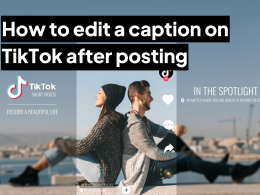
How to edit a caption on TikTok after posting
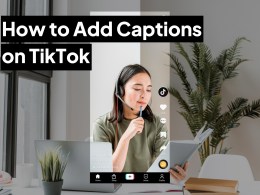
How to Add Captions on TikTok: A Beginner’s Guide

AI Generator
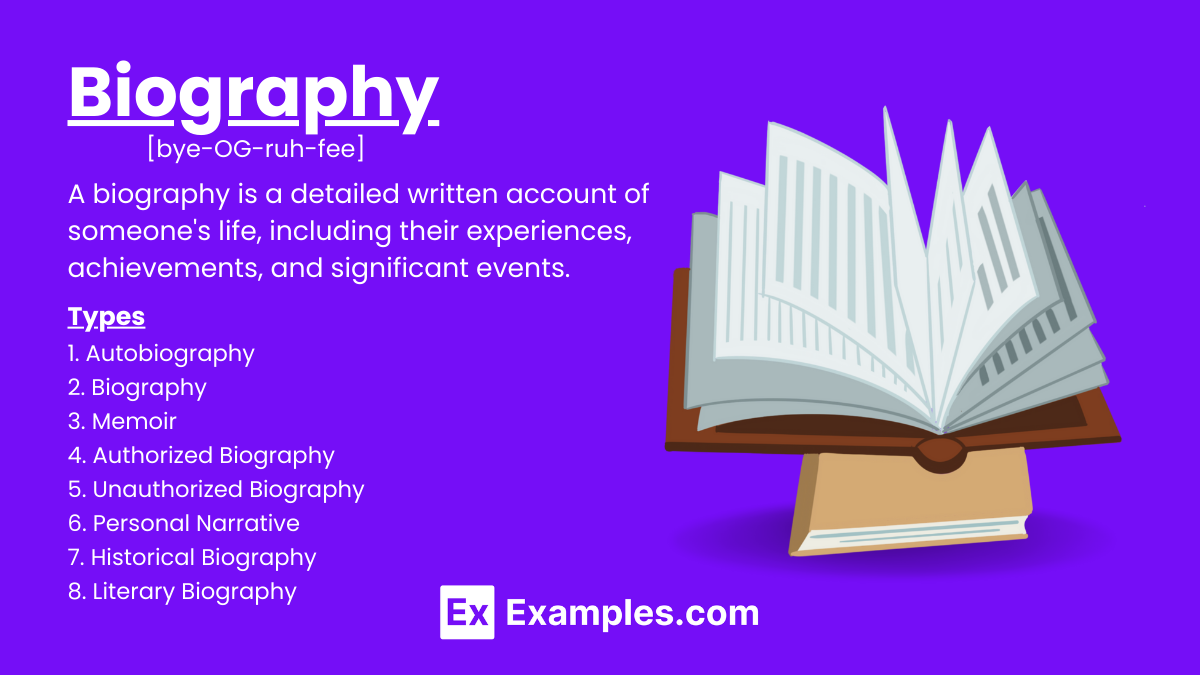
A biography is a detailed account of a person’s life, documenting their experiences, achievements, and impact on the world. It explores the subject’s personal and professional journeys, offering insights into their character and legacy.
What is Biography?
A bibliography is a comprehensive list of all sources consulted for a research project, including books, articles , websites, and more. It provides essential details such as the author, title, publication date, and publisher, formatted according to specific citation styles like APA, MLA , or Chicago. Bibliographies credit sources, avoid plagiarism, and enhance the credibility of your work.
Format of Biography
A well-structured biography format ensures that the narrative is both engaging and informative, offering readers a comprehensive view of the subject’s life. Here is a structured format that can be adapted to suit different types of biographies:
Title: Should capture the essence of the subject’s life. Subtitle: Optional, providing additional context or focus. Author’s Name: The name of the biographer.
Table of Contents
Lists chapters or sections with page numbers for easy navigation.
Introduction
Introduces the subject of the biography, including their significance and the scope of the biography. Provides a thesis statement or the main theme of the biography.
Birth and Family Background: Details about the subject’s birth, parents, siblings, and early family life. Education: Information on the subject’s education, including significant schools attended, degrees earned, and influential teachers or mentors. Formative Experiences: Early experiences that shaped the subject’s character, interests, and future path.
Early Career: Overview of the subject’s initial jobs or roles and early career milestones. Major Contributions and Achievements: Detailed account of the subject’s key contributions, achievements, and career highlights. Challenges and Setbacks: Challenges faced in their career and how they were overcome.
Personal Life
Relationships and Family: Information on the subject’s personal relationships, marriage(s), children, and close friendships. Interests and Hobbies: The subject’s personal interests, hobbies, and extracurricular activities.
Philanthropy and Activism
If applicable, details on the subject’s involvement in philanthropy, social causes, activism, or community service.
Legacy and Impact
Analysis of the subject’s legacy and impact on their field, community, or the world. Includes public and professional recognition, awards, and honors.
Later Life and Death
Details about the subject’s later years, retirement, and circumstances of their death (if applicable). Reflections on their life and contributions.
Summarizes the key points of the biography, reinforcing the subject’s impact and legacy. Reflects on the broader implications of the subject’s life and work.
Appendices (If Applicable)
Includes additional information, such as letters, documents, or photographs.
Bibliography/References
Lists sources, interviews, and materials used in researching the biography.
An alphabetical listing of names, places, and subjects mentioned in the biography, with page numbers.
Examples of Biography for Students
1. abraham lincoln (1809-1865).
Abraham Lincoln was the 16th President of the United States and is best known for leading the country during the Civil War and working to end slavery. Born in a log cabin in Hardin County, Kentucky, Lincoln had humble beginnings. He educated himself by reading books and became a lawyer in Illinois. His political career began in the Illinois State Legislature and later in the U.S. House of Representatives.
Lincoln became a national figure during the debates with Stephen Douglas in 1858, which highlighted his opposition to the expansion of slavery. In 1860, he was elected President. His presidency was dominated by the Civil War, a conflict between the Northern states (the Union) and the Southern states (the Confederacy), which had seceded from the Union. Lincoln’s leadership was crucial in preserving the Union.
In 1863, he issued the Emancipation Proclamation, which declared that all slaves in Confederate-held territory were free. This was a significant step towards the abolition of slavery. Lincoln was re-elected in 1864 but was assassinated by John Wilkes Booth in 1865, just days after the end of the Civil War.
Lincoln is remembered for his eloquent speeches, including the Gettysburg Address, and his dedication to principles of equality and freedom.
2. Malala Yousafzai (1997-Present)
Malala Yousafzai is a Pakistani education activist and the youngest Nobel Prize laureate. Born in Mingora, Pakistan, Malala developed a passion for education from an early age, inspired by her father, who was an educator and ran a girls’ school in their village.
In 2009, at just 11 years old, Malala began writing a blog for the BBC under a pseudonym, describing her life under the Taliban’s rule and their attempts to restrict education for girls. Her advocacy made her a target, and in 2012, she was shot in the head by a Taliban gunman while riding a bus home from school. Miraculously, she survived and was flown to the United Kingdom for extensive medical treatment.
Malala’s courage and determination gained international attention. In 2013, she co-authored the memoir “I Am Malala,” which became a global bestseller. In 2014, at the age of 17, she was awarded the Nobel Peace Prize for her struggle against the suppression of children and young people and for the right of all children to education.
Today, Malala continues to be a leading voice for education and women’s rights through the Malala Fund, an organization she co-founded to ensure girls around the world have access to 12 years of free, safe, and quality education.
3. Martin Luther King Jr. (1929-1968)
Martin Luther King Jr. was an American civil rights leader who played a pivotal role in the American civil rights movement. Born in Atlanta, Georgia, King was a Baptist minister and an advocate for nonviolent resistance based on the teachings of Mahatma Gandhi.
King first came to national prominence during the Montgomery Bus Boycott in 1955, which was sparked by Rosa Parks’ arrest for refusing to give up her seat to a white passenger. This boycott lasted for over a year and resulted in the desegregation of the city’s public buses.
In 1963, King led the March on Washington for Jobs and Freedom, where he delivered his iconic “I Have a Dream” speech, envisioning a future where people would be judged by their character rather than the color of their skin. His efforts were instrumental in the passing of the Civil Rights Act of 1964 and the Voting Rights Act of 1965.
King’s commitment to social justice and equality earned him the Nobel Peace Prize in 1964. Tragically, his life was cut short when he was assassinated in 1968 in Memphis, Tennessee. King’s legacy lives on through his speeches, writings, and the ongoing efforts for racial equality and justice in America.
4. Marie Curie (1867-1934)
Marie Curie was a pioneering physicist and chemist who conducted groundbreaking research on radioactivity. Born in Warsaw, Poland, as Maria Sklodowska, she moved to Paris to study at the Sorbonne, where she met her future husband, Pierre Curie. Together, they discovered the elements polonium and radium.
Marie Curie’s work earned her two Nobel Prizes—one in Physics in 1903 (shared with Pierre Curie and Henri Becquerel) and another in Chemistry in 1911. She was the first woman to win a Nobel Prize and remains the only person to have won Nobel Prizes in two different scientific fields.
Curie’s research contributed significantly to the understanding of radioactivity, a term she coined, and laid the foundation for future scientific advancements, including cancer treatment. Despite facing numerous challenges as a woman in science, Curie’s dedication and perseverance left a lasting legacy in the scientific community.
5. Nelson Mandela (1918-2013)
Nelson Mandela was a South African anti-apartheid revolutionary and political leader who served as President of South Africa from 1994 to 1999. Born in the village of Mvezo in Umtata, Mandela became involved in the anti-colonial and African nationalist politics while studying law in Johannesburg.
Mandela joined the African National Congress (ANC) in 1944 and co-founded the ANC Youth League. In the 1950s, he led peaceful protests and defiance campaigns against the apartheid regime’s racial segregation policies. However, after the government banned the ANC, Mandela shifted to advocating armed resistance.
In 1962, he was arrested and sentenced to life imprisonment for his activities against the apartheid government. Mandela spent 27 years in prison, during which he became a global symbol of resistance to apartheid. Released in 1990, Mandela led negotiations to dismantle apartheid and establish multiracial elections.
In 1994, Mandela was elected South Africa’s first black president in the country’s first democratic elections. His presidency focused on reconciliation, nation-building, and social justice. Mandela’s leadership and commitment to peace earned him international acclaim and numerous awards, including the Nobel Peace Prize in 1993.
Examples of Biography for Professionals
1. elon musk.
Elon Musk is a renowned entrepreneur and innovator, best known for his work in the technology and space exploration sectors. Born in Pretoria, South Africa, in 1971, Musk moved to the United States to pursue his ambitions in the tech industry. He earned degrees in Physics and Economics from the University of Pennsylvania.
Musk co-founded Zip2, an online city guide software, which was sold to Compaq for nearly $300 million in 1999. He then founded X.com, an online payment company, which later became PayPal and was acquired by eBay for $1.5 billion in stock.
In 2002, Musk founded SpaceX with the goal of reducing space transportation costs to enable the colonization of Mars. SpaceX has since achieved numerous milestones, including the first privately-funded spacecraft to reach the International Space Station.
Musk is also the CEO of Tesla, Inc., a company dedicated to producing electric vehicles and renewable energy solutions. Under his leadership, Tesla has become a leader in the automotive industry, pushing the boundaries of electric car technology and sustainable energy.
Musk’s other ventures include Neuralink, a neurotechnology company, and The Boring Company, which focuses on tunnel construction and infrastructure. His innovative approach and relentless drive continue to shape the future of technology and space exploration.
2. Sheryl Sandberg
Sheryl Sandberg is the Chief Operating Officer (COO) of Facebook (now Meta Platforms, Inc.) and a prominent advocate for women’s leadership and empowerment. Born in Washington, D.C., in 1969, Sandberg earned her Bachelor’s degree in Economics from Harvard University and later an MBA from Harvard Business School.
Sandberg started her career as a management consultant at McKinsey & Company before joining the U.S. Treasury Department as Chief of Staff under President Bill Clinton. In 2001, she joined Google, where she was Vice President of Global Online Sales and Operations, significantly contributing to the company’s revenue growth.
In 2008, Sandberg became the COO of Facebook, where she helped scale the company’s operations and expand its global presence. Her leadership was instrumental in turning Facebook into one of the world’s largest and most influential social media platforms.
Sandberg is also the author of the best-selling book “Lean In: Women, Work, and the Will to Lead,” which encourages women to pursue their ambitions and challenge workplace inequalities. She founded LeanIn.Org, a nonprofit organization dedicated to supporting women’s professional growth and leadership.
Sandberg’s influence extends beyond her professional achievements, as she continues to advocate for gender equality and empowerment in the workplace.
3. Satya Nadella
Satya Nadella is the Chief Executive Officer (CEO) of Microsoft, one of the world’s leading technology companies. Born in Hyderabad, India, in 1967, Nadella moved to the United States to pursue his education, earning a Bachelor’s degree in Electrical Engineering from Manipal Institute of Technology, a Master’s degree in Computer Science from the University of Wisconsin-Milwaukee, and an MBA from the University of Chicago Booth School of Business.
Nadella joined Microsoft in 1992 and held various leadership roles in the company’s enterprise and cloud computing divisions. He played a crucial role in transforming Microsoft’s business model to focus on cloud computing, which significantly boosted the company’s growth and profitability.
In 2014, Nadella was appointed CEO of Microsoft. Under his leadership, Microsoft has embraced a culture of innovation and collaboration, expanding its product offerings and investing heavily in artificial intelligence, cloud computing, and other advanced technologies. Nadella’s vision has been pivotal in maintaining Microsoft’s status as a global technology leader.
Nadella is also known for his emphasis on empathy and inclusive leadership, which has helped foster a more diverse and supportive workplace culture at Microsoft.
4. Indra Nooyi
Indra Nooyi is a distinguished business executive and former CEO of PepsiCo, one of the world’s largest food and beverage companies. Born in Chennai, India, in 1955, Nooyi earned her Bachelor’s degree in Physics, Chemistry, and Mathematics from Madras Christian College and an MBA from the Indian Institute of Management Calcutta. She later obtained a Master’s degree in Public and Private Management from Yale School of Management.
Nooyi began her career at Johnson & Johnson and later worked at Boston Consulting Group and Motorola. In 1994, she joined PepsiCo and quickly rose through the ranks, becoming CFO in 2001 and CEO in 2006.
During her tenure as CEO, Nooyi led PepsiCo through a period of significant growth and transformation, focusing on product innovation, health and wellness, and sustainability. She spearheaded the acquisition of Tropicana and the merger with Quaker Oats, expanding PepsiCo’s portfolio and market presence.
Nooyi’s leadership earned her numerous accolades, including being consistently ranked among the world’s most powerful women by Forbes and Fortune. She is also known for her advocacy for diversity and inclusion in the workplace and her commitment to corporate social responsibility.
After stepping down as CEO in 2018, Nooyi continues to serve on various boards and remains an influential voice in the business community.
5. Jeff Bezos
Jeff Bezos is the founder and former CEO of Amazon, one of the world’s largest and most influential e-commerce and technology companies. Born in Albuquerque, New Mexico, in 1964, Bezos showed an early interest in science and technology. He graduated summa cum laude from Princeton University with degrees in Electrical Engineering and Computer Science.
Bezos worked in the finance industry before founding Amazon in 1994 from his garage. Initially an online bookstore, Amazon quickly expanded its product offerings and grew into a global e-commerce giant. Bezos’s customer-centric approach and relentless focus on innovation have been key drivers of Amazon’s success.
Under Bezos’s leadership, Amazon introduced groundbreaking services such as Amazon Prime, Amazon Web Services (AWS), and Kindle, transforming the retail and technology landscapes. Bezos also acquired The Washington Post in 2013, revitalizing the newspaper through digital innovation.
In 2021, Bezos stepped down as CEO of Amazon to focus on his other ventures, including Blue Origin, a space exploration company he founded to make space travel more accessible. Bezos’s impact on e-commerce, technology, and space exploration continues to shape the future of these industries.
Examples of Biography for Kids
1. albert einstein.
Albert Einstein was one of the most famous scientists of all time. Born on March 14, 1879, in Ulm, Germany, Einstein showed a great interest in math and science from a young age. When he was just a teenager, he taught himself advanced mathematics.
Einstein is best known for his theory of relativity, which changed the way we understand time and space. He developed the famous equation E=mc², which explains how energy and mass are related. This discovery had a huge impact on science and technology.
In 1921, Einstein won the Nobel Prize in Physics for his work on the photoelectric effect, which helped scientists understand how light works. He moved to the United States in 1933 and worked at Princeton University.
Einstein was also known for his wild hair and playful personality. He loved to play the violin and was passionate about peace and human rights. He passed away on April 18, 1955, but his discoveries continue to inspire scientists around the world.
2. Helen Keller
Helen Keller was an extraordinary woman who overcame incredible obstacles. Born on June 27, 1880, in Tuscumbia, Alabama, Keller lost her sight and hearing due to an illness when she was just 19 months old. Despite these challenges, she became a famous author, speaker, and advocate for people with disabilities.
When Keller was six years old, her parents hired a teacher named Anne Sullivan to help her learn. Sullivan taught Keller how to communicate using sign language and braille. Keller quickly learned to read and write, and she even learned to speak.
Keller attended college and graduated with honors in 1904. She wrote several books, including her autobiography, “The Story of My Life.” She traveled the world, giving speeches and raising awareness about the abilities of people with disabilities.
Helen Keller’s determination and achievements continue to inspire people today. She showed that with hard work and perseverance, anything is possible. She passed away on June 1, 1968, but her legacy lives on.
3. Neil Armstrong
Neil Armstrong was an American astronaut and the first person to walk on the moon. Born on August 5, 1930, in Wapakoneta, Ohio, Armstrong was fascinated by airplanes and space from a young age. He earned his pilot’s license at just 16 years old.
Armstrong studied aerospace engineering and became a test pilot for NASA. In 1962, he was selected to be an astronaut. On July 20, 1969, Armstrong made history when he stepped onto the moon during the Apollo 11 mission. He famously said, “That’s one small step for man, one giant leap for mankind.”
Armstrong and his fellow astronauts, Buzz Aldrin and Michael Collins, safely returned to Earth, and they were celebrated as heroes. After his historic mission, Armstrong continued to work in aviation and space exploration.
Neil Armstrong’s bravery and accomplishments continue to inspire future generations of explorers. He passed away on August 25, 2012, but his journey to the moon remains one of the greatest achievements in human history.
4. Jane Goodall
Jane Goodall is a British primatologist and anthropologist who is famous for her groundbreaking work with chimpanzees. Born on April 3, 1934, in London, England, Goodall was fascinated by animals from a young age. She dreamed of living in Africa and studying wildlife.
In 1960, at the age of 26, Goodall traveled to Tanzania to study chimpanzees in the wild. She observed their behavior and discovered that they used tools, a trait previously thought to be unique to humans. Her work changed the way scientists understand primates and their similarities to humans.
Goodall founded the Jane Goodall Institute in 1977 to support wildlife research, education, and conservation. She has spent her life advocating for the protection of animals and the environment, traveling the world to share her message.
Jane Goodall’s passion and dedication have made her a hero to many people who care about animals and the planet. Her work continues to inspire young scientists and conservationists around the world.
5. Rosa Parks
Rosa Parks was a civil rights activist who became famous for her role in the Montgomery Bus Boycott. Born on February 4, 1913, in Tuskegee, Alabama, Parks grew up in a time when African Americans faced widespread discrimination and segregation.
On December 1, 1955, Parks refused to give up her seat to a white passenger on a bus in Montgomery, Alabama. Her act of defiance sparked the Montgomery Bus Boycott, a protest against the city’s segregation laws. The boycott lasted for over a year and led to the desegregation of the public bus system.
Parks’ courage made her a symbol of the civil rights movement. She worked alongside other leaders like Martin Luther King Jr. to fight for equality and justice. Parks received many honors for her work, including the Presidential Medal of Freedom and the Congressional Gold Medal.
Rosa Parks’ bravery and determination continue to inspire people to stand up for what is right. She passed away on October 24, 2005, but her legacy as a champion of civil rights lives on.
Personal Biography Examples
1. author bio.
Name: Jane Smith Occupation: Author
Jane Smith is a bestselling author known for her compelling narratives and complex characters. Her debut novel, “Echoes of the Heart,” captivated readers worldwide and was awarded the prestigious National Book Award. With a background in journalism and a passion for storytelling, Jane weaves intricate plots that explore the depths of human emotions and relationships. When she’s not writing, Jane enjoys hiking, painting, and spending time with her family in the picturesque countryside of Vermont.
2. Personal Blog Bio
Name: Mark Davis Occupation: Travel Blogger
Mark Davis is an avid traveler and the voice behind the popular blog “Wanderlust Adventures.” With a mission to inspire others to explore the world, Mark shares his experiences and tips from over 50 countries. His journey began as a solo backpacker through Southeast Asia and has since evolved into a full-time adventure, capturing the beauty and culture of each destination. Mark’s blog features stunning photography, in-depth guides, and personal anecdotes that resonate with fellow wanderers. When he’s not on the road, Mark enjoys cooking international cuisines and planning his next trip from his home base in New York City.
3. LinkedIn Bio
Name: Emily Johnson Occupation: Marketing Professional
Emily Johnson is a dynamic marketing professional with over a decade of experience in creating and executing successful marketing strategies. Currently, she is the Marketing Director at Bright Ideas Co., where she leads a talented team in driving brand awareness and customer engagement. Emily holds a Bachelor’s degree in Marketing from the University of California, Los Angeles, and an MBA from Stanford University. Known for her innovative approach and analytical mindset, Emily has a proven track record of boosting sales and enhancing brand loyalty. Outside of work, she is passionate about mentoring young professionals and volunteering at local animal shelters.
4. Instagram Bio
Name: Alex Chen Occupation: Fitness Enthusiast
Alex Chen is a fitness enthusiast dedicated to promoting a healthy and active lifestyle. With a background in personal training and nutrition, Alex shares workout routines, healthy recipes, and motivational content on his Instagram page, @FitLifeAlex. His journey began with a personal transformation that ignited his passion for fitness, and now he inspires thousands of followers to achieve their fitness goals. Alex believes in balance and encourages his community to find joy in their fitness journey. When he’s not at the gym, Alex enjoys hiking, experimenting with new recipes, and spending time with his dog, Rocky.
5. Artist Bio
Name: Lisa Martinez Occupation: Visual Artist
Lisa Martinez is a visual artist whose work explores the intersection of nature and human experience. With a Master’s degree in Fine Arts from the School of the Art Institute of Chicago, Lisa has exhibited her paintings and installations in galleries across the United States. Her work is characterized by vibrant colors, organic forms, and a deep connection to the environment. Lisa draws inspiration from her travels and the natural world, often incorporating sustainable materials into her pieces. When she’s not in the studio, Lisa enjoys teaching art workshops and exploring national parks with her sketchbook in hand.
Artists Biography Examples
1. visual artist.
Name: Sophia Rivera Medium: Painting and Sculpture
Sophia Rivera is a contemporary visual artist known for her evocative paintings and intricate sculptures. Based in New York City, Sophia has been creating art that explores themes of identity, memory, and transformation for over 15 years. She holds an MFA from the Pratt Institute and has exhibited her work in solo and group shows across the United States and Europe. Sophia’s use of bold colors and mixed media techniques challenges traditional boundaries and invites viewers to engage with her pieces on a personal level. In addition to her studio practice, Sophia teaches art workshops and mentors emerging artists.
2. Photographer
Name: David Lee Medium: Photography
David Lee is an award-winning photographer whose work captures the raw beauty and complexity of urban life. With a keen eye for detail and a passion for storytelling, David’s photographs reveal the hidden narratives of cityscapes and their inhabitants. He graduated with a degree in Fine Arts from the School of Visual Arts in New York and has since been featured in numerous galleries and publications worldwide. David’s recent project, “Metropolis,” explores the interplay of light and shadow in metropolitan environments. When not behind the lens, David enjoys traveling, teaching photography, and collaborating with other creatives.
3. Digital Artist
Name: Mia Thompson Medium: Digital Art
Mia Thompson is a digital artist known for her innovative use of technology to create immersive and interactive art experiences. Based in Los Angeles, Mia’s work spans digital illustrations, animations, and virtual reality installations. She earned her Bachelor’s degree in Digital Media from the California Institute of the Arts and has worked with leading tech companies and art institutions. Mia’s art often explores themes of futurism, identity, and the digital age, pushing the boundaries of how art can be experienced. Her recent VR exhibition, “Beyond the Screen,” received critical acclaim for its groundbreaking approach to digital storytelling.
4. Musician
Name: Alex Martinez Medium: Music
Alex Martinez is a singer-songwriter and multi-instrumentalist whose music blends elements of folk, rock, and indie pop. Hailing from Austin, Texas, Alex has been performing and writing music since his teens, drawing inspiration from personal experiences and the world around him. He has released three albums, with his latest, “Wandering Heart,” earning a spot on the Billboard Top 100. Alex’s soulful lyrics and melodic compositions resonate with audiences of all ages. When he’s not touring, Alex is passionate about music education and works with local schools to inspire the next generation of musicians.
5. Film Director
Name: Raj Patel Medium: Film
Raj Patel is an acclaimed film director known for his thought-provoking and visually stunning films. Born in Mumbai and now based in Los Angeles, Raj’s work often explores themes of cultural identity, social justice, and human connection. He studied film at the University of Southern California and has directed several award-winning films that have been screened at major international film festivals. Raj’s most recent film, “Echoes of Silence,” received widespread praise for its powerful storytelling and cinematography. In addition to directing, Raj is committed to mentoring young filmmakers and advocating for greater diversity in the film industry.

Short Biography Examples
Albert Einstein (1879-1955) was a German-born physicist renowned for his theory of relativity and the famous equation E=mc². His groundbreaking work laid the foundation for modern physics and earned him the Nobel Prize in Physics in 1921. Despite facing numerous challenges, including fleeing Nazi Germany, Einstein’s contributions to science and his advocacy for peace and human rights have left an indelible mark on the world.
2. Rosa Parks
Rosa Parks (1913-2005) was an American civil rights activist whose refusal to give up her bus seat to a white passenger in Montgomery, Alabama, in 1955 sparked the Montgomery Bus Boycott. Her act of defiance became a symbol of the struggle for racial equality and helped propel the civil rights movement forward. Parks’ bravery and commitment to justice continue to inspire generations.
3. Leonardo da Vinci
Leonardo da Vinci (1452-1519) was an Italian Renaissance polymath whose contributions spanned art, science, and engineering. Best known for masterpieces like the “Mona Lisa” and “The Last Supper,” da Vinci’s work exemplifies the blend of art and scientific inquiry. His detailed studies and inventive designs have influenced countless fields, making him one of history’s most celebrated geniuses.
4. Marie Curie
Marie Curie (1867-1934) was a pioneering physicist and chemist who conducted groundbreaking research on radioactivity. She was the first woman to win a Nobel Prize and remains the only person to have won Nobel Prizes in two different scientific fields (Physics and Chemistry). Curie’s work not only advanced scientific understanding but also paved the way for future generations of women in science.
5. Nelson Mandela
Nelson Mandela (1918-2013) was a South African anti-apartheid revolutionary and the first black president of South Africa. Imprisoned for 27 years for his activism, Mandela emerged as a global symbol of resistance to apartheid and a leader in the fight for racial equality. His presidency and lifelong dedication to peace and reconciliation have left a lasting legacy on the world stage.
6. Jane Goodall
Jane Goodall (1934-Present) is a British primatologist and anthropologist known for her groundbreaking studies of chimpanzees in Tanzania. Her observations and research have transformed our understanding of primates and their behaviors. Goodall’s commitment to conservation and animal welfare has made her an influential advocate for environmental sustainability.
7. Steve Jobs
Steve Jobs (1955-2011) was an American entrepreneur and co-founder of Apple Inc. Known for his visionary leadership and innovation, Jobs played a crucial role in the development of revolutionary products like the iPhone, iPad, and Mac. His impact on technology and consumer electronics has shaped the modern digital landscape and continues to influence the industry.
8. Malala Yousafzai
Malala Yousafzai (1997-Present) is a Pakistani education activist and the youngest Nobel Prize laureate. After surviving a Taliban assassination attempt for advocating girls’ education, Malala co-authored her memoir “I Am Malala” and founded the Malala Fund to champion education for girls worldwide. Her courage and advocacy work have made her a global symbol of resilience and empowerment.
9. Walt Disney
Walt Disney (1901-1966) was an American animator, film producer, and entrepreneur, best known for creating Disney Studios and iconic characters like Mickey Mouse. His innovative spirit and storytelling revolutionized the entertainment industry, leading to the creation of Disneyland and Disney World. Disney’s legacy lives on through his beloved films and theme parks.
10. Amelia Earhart
Amelia Earhart (1897-1937) was an American aviator and the first woman to fly solo across the Atlantic Ocean. Her daring spirit and achievements in aviation made her an international icon and a symbol of women’s empowerment. Despite her mysterious disappearance during an attempted around-the-world flight, Earhart’s legacy continues to inspire future generations of aviators and adventurers.
More Biography Samples & Examples in PDF
1. biography sample.
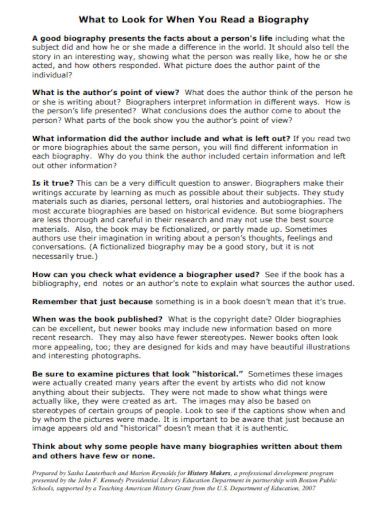
2. Biography of Heroes and Heroines
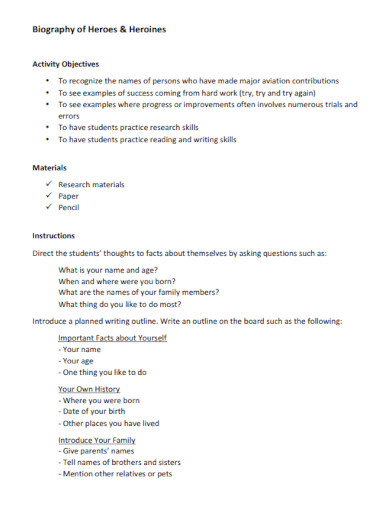
3. Social Biography
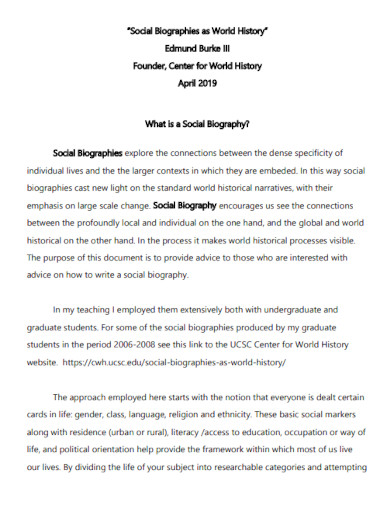
4. Author Biography
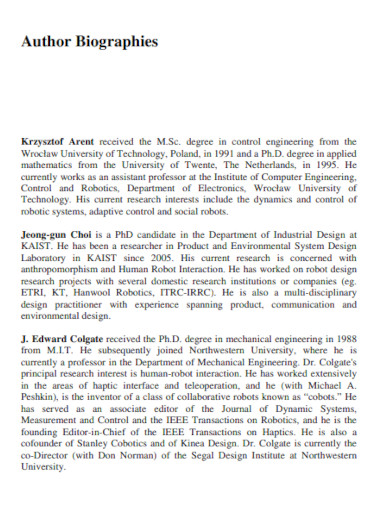
5. Short Biography
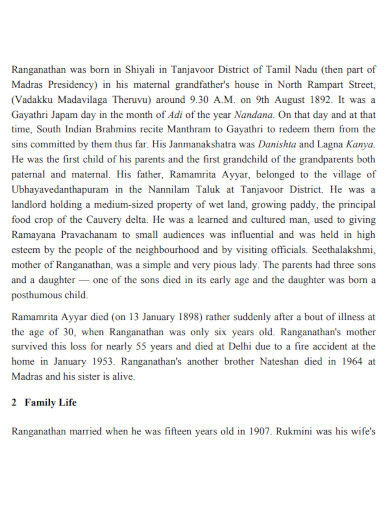
6. Student Biography
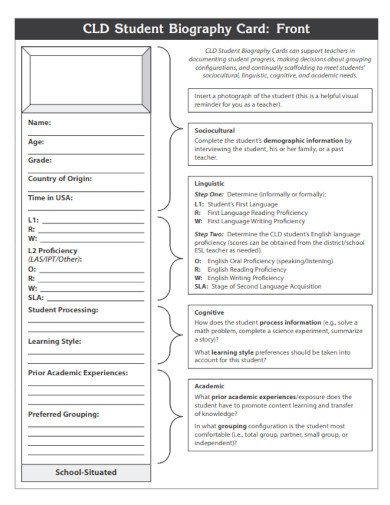
7. Historical Biography Example
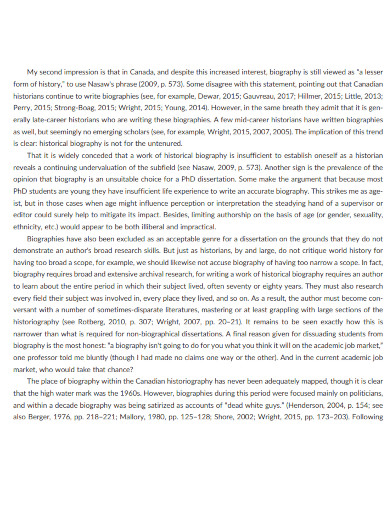
8. Object Biography
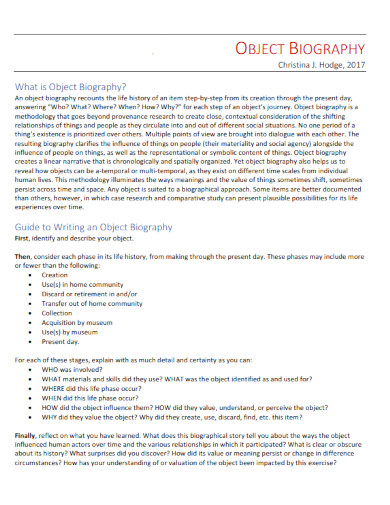
9. Features of Biography
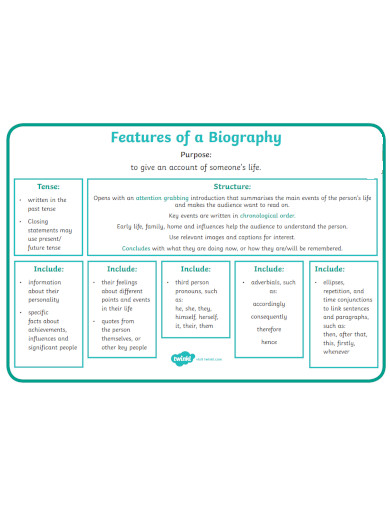
10. Biography Example PDF
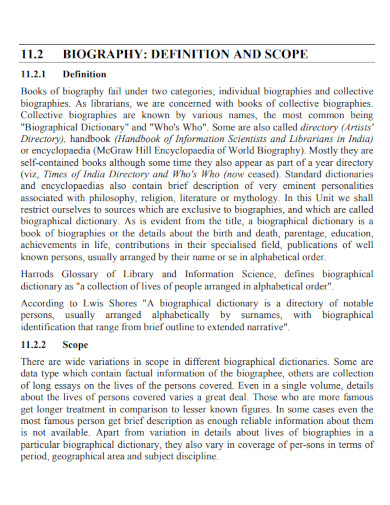
Types of Biography
Biographies come in various forms, each offering a unique perspective on an individual’s life. Understanding the types of biographies can help readers choose the one that best suits their interest or research needs. Here are the main types:
1. Autobiography
- Written by the subject themselves, an autobiography is a self-narrated account of one’s life. It provides personal insights and perspectives, offering a detailed look into the author’s experiences, thoughts, and feelings.
- Focus: Personal journey, challenges, successes, and reflections.
- A memoir is a subset of autobiography but focuses more on specific aspects or periods of the writer’s life rather than a comprehensive life history. It often explores themes, emotions, and personal growth.
- Focus: Emotional journey, significant events, or relationships.
3. Biography
- A biography is an account of someone’s life written by someone else. It covers various aspects of the subject’s life, including their achievements, personal life, and impact on society.
- Focus: Objective analysis, historical context, and comprehensive life story.
4. Authorized Biography
- Authorized biographies are written with the subject’s permission, cooperation, or endorsement. This access can lead to more detailed and personal insights but may also reflect the subject’s bias or desired legacy.
- Focus: Collaborative storytelling, often with direct input from the subject.
5. Unauthorized Biography
- Written without the subject’s permission, unauthorized biographies might offer a more critical or controversial perspective. They rely on public records and third-party interviews, which can lead to disputes about accuracy.
- Focus: Independent research, potentially revealing unknown aspects.
6. Academic Biography
- These biographies are written with a focus on scholarly research, often detailing the subject’s contributions to a specific field. They are usually well-documented and cited, aiming for academic audiences.
- Focus: Scholarly analysis, contributions to the field, and historical impact.
7. Collective Biography
- Also known as group biography, it explores the lives of a group of individuals who share a common theme, profession, or period. It provides a broader perspective on the impact of a collective group.
- Focus: Group dynamics, collective contributions, and shared experiences.
8. Fictional Biography
- These are imaginative accounts that blend facts with fiction, often to fill in gaps in historical records or to create a more engaging narrative. While based on real people, these stories are partly or largely fictionalized.
- Focus: Entertainment, speculative history, and narrative creativity.
Different Aspects of Biography
Biographies encompass several dimensions that contribute to their depth and appeal. Understanding these aspects can enhance both the reading and writing of biographies, offering a more comprehensive view of the subject’s life.
1. Historical Context
This aspect involves placing the subject’s life within the broader historical period in which they lived. It includes the examination of social, political, and cultural events that influenced or were influenced by the subject.
2. Personal Background
This covers the subject’s family origins, upbringing, education, and early life experiences. It helps to understand the foundation upon which they built their achievements and character.
3. Career and Achievements
A critical focus is often on the subject’s professional life, including their career path, significant achievements, contributions to their field, and any obstacles they overcame along the way.
4. Psychological Dimension
Exploring the subject’s personality, motivations, values, and internal struggles offers insights into their actions and decisions. This aspect adds depth, showing the human behind the accomplishments.
5. Personal Relationships
The examination of key relationships in the subject’s life, including family, friends, mentors, and rivals, reveals how these interactions influenced their journey and development.
6. Impact and Legacy
Assessing the subject’s long-term impact on their field, community, or the world highlights their lasting legacy. This includes their influence on future generations, societal changes, or advancements in their area of expertise.
7. Controversies and Challenges
Addressing any controversies, criticisms, or significant challenges faced by the subject provides a balanced view of their life, showcasing resilience, perseverance, or, in some cases, their vulnerabilities.
8. Cultural and Social Contributions
This aspect looks at the subject’s contributions beyond their professional achievements, including their role in societal movements, cultural shifts, philanthropy, and public service.
Characteristics of a Biography
A biography is a detailed account of a person’s life written by someone else. Here are the key characteristics of a biography:
1. Fact-Based
Biographies are based on factual information about the person’s life, including dates, places, and events. They rely on verifiable data and aim to provide an accurate portrayal of the individual.
2. Chronological Structure
Biographies typically follow a chronological order, starting from the subject’s birth and proceeding through their life events. This structure helps readers understand the progression of the person’s life and the context of their achievements.
3. Comprehensive Coverage
A good biography covers all significant aspects of the person’s life, including their childhood, education, career, personal relationships, and major life events. It provides a holistic view of the individual.
4. Detailed and Descriptive
Biographies often include detailed descriptions of events, people, and places. They provide context and background information to help readers understand the significance of the subject’s experiences.
5. Focus on Achievements and Impact
Biographies highlight the subject’s achievements, contributions, and the impact they had on their field or society. This focus helps readers appreciate the individual’s importance and legacy.
6. Personal Anecdotes and Stories
Incorporating personal anecdotes and stories makes a biography more engaging and relatable. These elements provide insight into the subject’s personality, character, and motivations.
7. Objective and Balanced
While biographies may reflect the author’s perspective, they strive to present a balanced and objective view of the subject. They include both positive and negative aspects of the person’s life, providing a nuanced portrayal.
8. Use of Primary and Secondary Sources
Biographies rely on primary sources (such as letters, diaries, interviews) and secondary sources (such as books, articles, documentaries) to gather information. The use of credible sources ensures the accuracy and reliability of the content.
9. Exploration of Influences and Motivations
A biography often explores the influences and motivations behind the subject’s actions and decisions. This exploration helps readers understand the factors that shaped the individual’s life and career.
10. Narrative Style
Biographies are written in a narrative style, telling the story of the person’s life in a compelling and engaging manner. This style makes the biography enjoyable to read and helps maintain the reader’s interest.
What is included in a Biography?
A biography provides a comprehensive account of a person’s life, detailing significant events, achievements, and influences. Here are the key components typically included in a biography:
1. Basic Information
- Date and Place of Birth
- Date and Place of Death (if applicable)
- Nationality
2. Early Life and Background
- Family Background : Information about parents, siblings, and other family members.
- Childhood Experiences : Notable events, upbringing, and early interests.
- Education : Schools attended, academic achievements, and notable teachers or mentors.
3. Career and Major Achievements
- Career Beginnings : First jobs or roles and how the person started in their field.
- Significant Positions and Roles : Important jobs, titles, and responsibilities held.
- Major Achievements : Key accomplishments, awards, and recognitions.
- Impact and Contributions : How their work or actions influenced their field or society.
4. Personal Life
- Relationships : Information about significant relationships, marriages, and children.
- Hobbies and Interests : Personal interests, hobbies, and activities outside of their professional life.
- Challenges and Struggles : Personal or professional obstacles and how they were overcome.
5. Influences and Motivations
- Influences : People, events, or experiences that significantly influenced their life and career.
- Motivations : Insights into what drove them to achieve their goals and aspirations.
6. Anecdotes and Personal Stories
- Memorable Events : Interesting or significant stories from their life.
- Personal Quotes : Quotations that capture their personality or philosophy.
- Lasting Impact : How they are remembered and their long-term contributions to their field or society.
- Recognition and Honors : Posthumous honors, awards, or memorials.
8. Illustrative Material
- Photographs : Images of the person at various stages of their life.
- Documents : Important letters, awards, certificates, or other relevant documents.
Biography vs. Autobiography
How to write a biography.
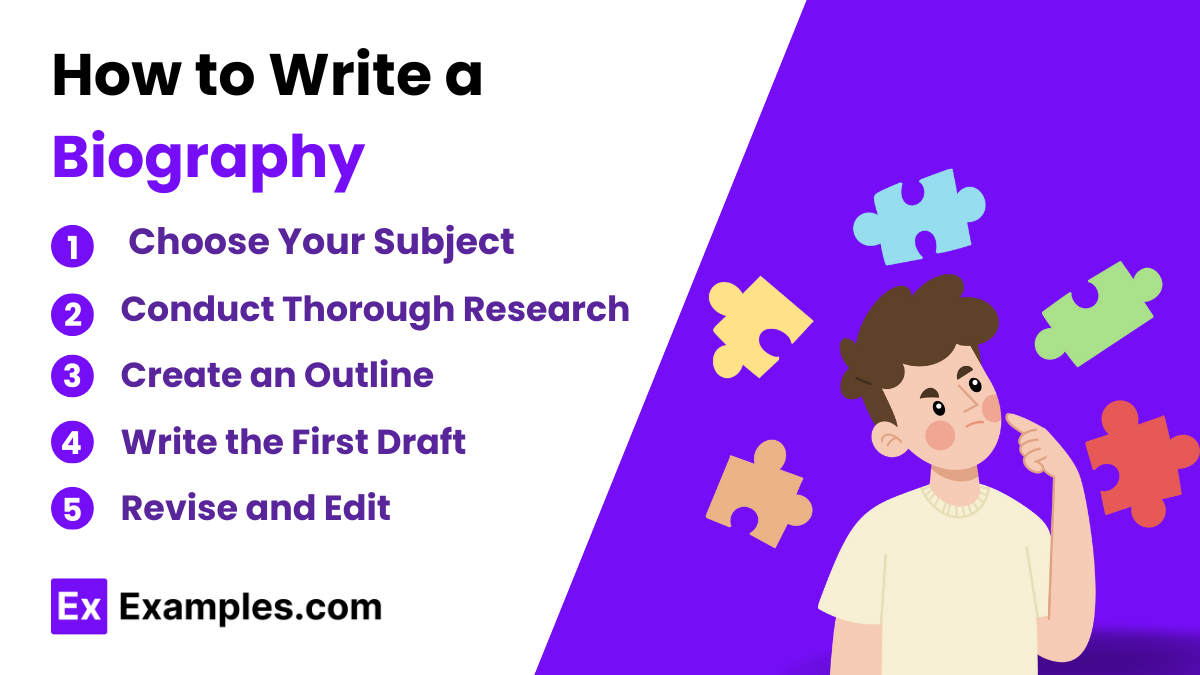
A well-written biography allows readers to have insight into the person’s life. Examples of well-written biographies include Steve Jobs a biography written by Walter Isaacson and Young Stalin by Simon Sebag Montefiore. If you are still confused about biographies and are still unsure about the whole writing process you may look at the biography examples, samples , and PDFs on the list above.
1.Obtain Permission from the Individual
Begin by obtaining permission from the individual you are writing about. Biographies can be made without the permission of the chosen individual, but having the permission of the individual will help provide more substantial information and gives you access to the thoughts of the chosen individual. Not only that, but their approval will also increase the chances of you being able to interview your chosen individual.
2.Research the Individual
Regardless if you have obtained the permission of the chosen individual, you will need to research the life of your subject. This means you must read articles, reports, and various articles all about the life of your subject. Not only must you read, but you must also interview people associated with and related to your subject’s life. Because of the factual nature of a biography , you must ensure that the data and information you are providing are factual, accurate, and credible.
3.Create a Timeline of Events
After you have completed your research, you will need to create a timeline of the events the subject has lived through. This will help create an outline and a reference that you can in your writing. Not only that but it will also help root out any inconsistencies in the information you have gathered or researched.
4.Write the Biography
Using the timeline, write down the biographical information of the person. Note that this step will be the longest and may take months or even years to accomplish.
5.Write Down Your Thoughts and Opinions.
After you have finished the biography properly, you can write down your thoughts and feelings about the biography to give it a bit of a personal flair and touch. This will help connect you to your target audience. When you have finished with everything, be sure to edit and revise the contents of the biography as you see fit.
How is a biography structured?
A biography typically follows a chronological structure, starting from the subject’s birth and covering significant life events, achievements, and influences in sequence.
What sources are used in a biography?
Biographies use various sources like interviews, letters, diaries, official documents, and historical records to provide accurate and comprehensive information.
Why are biographies important?
Biographies offer insights into the lives of influential individuals, highlighting their contributions and the impact they had on society and history.
Can a biography be biased?
Yes, a biography can reflect the biographer’s perspective and potential biases, although it aims to be objective and balanced.
What is the difference between an authorized and unauthorized biography?
An authorized biography is approved by the subject or their estate, while an unauthorized biography is written without their permission or input.
Who can write a biography?
Anyone with access to reliable information and the ability to research and write comprehensively can write a biography.
How long does it take to write a biography?
Writing a biography can take several months to years, depending on the depth of research and the complexity of the subject’s life.
What makes a biography compelling?
A compelling biography includes detailed descriptions, personal anecdotes, and insights that make the subject’s life story engaging and relatable.
How do biographers verify their information?
Biographers verify information through cross-referencing multiple sources, conducting interviews, and reviewing historical records and documents.
Can a biography include fictional elements?
No, biographies should be factual and based on verifiable information. Fictional elements are not appropriate for a biography.
Text prompt
- Instructive
- Professional
10 Examples of Public speaking
20 Examples of Gas lighting
Business , Education
24 Biography Templates and Examples (Word | PDF | Google Docs)
Biographies serve as a fascinating lens into the lives of individuals, ranging from influential family members and historical figures to renowned personalities. Whether you’re a student, an aspiring writer, or someone captivated by the art of telling a life story , grasping the essential elements of a biography is vital. Writing a biography goes beyond compiling facts; it involves crafting a narrative that educates and inspires your readers. This guide provides you with practical steps, style advice, and, importantly, biography templates to assist you in structuring your work effectively. With these resources, you can start to create biographies that not only inform but also captivate your audience. Are you ready to capture the essence of a life story in words? Let’s delve into the fundamentals of crafting a compelling and memorable biography.
Biography Templates & Examples

Aesthetic Biography Template
An Aesthetic Biography Template is a carefully designed layout that allows individuals to present their personal and professional information in an organized and visually appealing manner. The template provided in the previous response offers a structured format for users to showcase their educational background, work experience, skills, and personal interests. This format is particularly useful for creating a compelling narrative of one's life and achievements, making it ideal for applications, personal websites, or professional profiles. The inclusion of sample data guides users on how to effectively fill out each section, ensuring clarity and coherence in presenting their unique story.

Short Biography Template
A Short Biography template is a structured format for summarizing an individual's personal, educational, and professional background. It offers a concise yet informative way to present one's achievements, skills, and experiences. The template provided above is designed to capture a wide range of details, from basic personal information to career highlights and skills. It is versatile and can be tailored to suit different situations, whether for a professional profile, a speaker introduction, or a personal website. The inclusion of sample data in the brackets makes it user-friendly, allowing for easy customization. This template serves as a useful starting point for anyone looking to create a clear and engaging biography.

Professional Biography Template
A Professional Bio Template is a structured format designed to aid individuals in crafting a succinct and engaging biography that highlights their career achievements, skills, and personal qualities. This template helps users efficiently organize and present their professional story, ensuring that key elements like career milestones, skills, and personal interests are effectively communicated. This assists in creating a compelling bio that resonates with various audiences, such as potential employers or networking contacts, enhancing their professional presence and impact.

Personal Biography Template
A personal biography template is a structured outline designed to guide individuals in documenting their life stories, achievements, and experiences. It provides a framework to organize personal details in a coherent and engaging manner. This template, created in our prior response, can assist users by simplifying the process of writing their biography. It offers a clear structure, ensuring that key aspects of one's life are highlighted effectively. This can be particularly useful for creating professional bios, personal introductions, or for preserving personal history.
You can explore more free biography templates and examples in the collection at Highfile . This resource offers a diverse range of templates suitable for various needs, whether for professional, personal, or academic purposes.

What Is a Biography?
A biography is an in-depth narrative of someone’s life, written by another person. It encompasses more than just basic facts like birthplace and education. A biography delves into the subject’s personal experiences, significant life events, and the influences that shaped their character and achievements. It’s not just a timeline of events; a biography weaves these details into a compelling story, offering insights into the individual’s motivations and impacts. The aim is to present a well-rounded portrait that is both informative and engaging, allowing readers to understand and empathize with the subject’s journey. A biography, in essence, is a vivid window into another person’s life experience, capturing their unique contributions and the essence of their existence.
Fun Fact: Did you know that one of the earliest biographies ever recorded was about an ancient Egyptian official named Ptahhotep around 2400 BC? This ancient biography was not written in a book but carved on the walls of his tomb, depicting his life and achievements. This highlights how the art of biography writing has been significant throughout human history, evolving from ancient carvings to modern digital formats!
Essential Elements of a Biography Template
Crafting a professional biography involves creating a concise yet comprehensive summary of your career objectives, current position, and notable achievements. This type of bio is ideally suited for professional networking platforms like LinkedIn or AngelList, where a more detailed and career-focused narrative is expected compared to the brief bios often seen on other social media sites.
Key Components to Include in Your Professional Biography:
- Your Name : Clearly state your full name at the beginning.
- Personal Brand or Company Affiliation : Mention your business or the brand you represent.
- Professional Tagline or Current Role : Include your current job title or a tagline that encapsulates your professional essence.
- Career Aspirations : Briefly outline your career goals or what you aim to achieve professionally.
- Unique Personal Fact : Share an interesting personal detail that sets you apart.
- Top Achievements : Highlight two or three significant accomplishments relevant to your professional trajectory.
While primarily professional in tone, don’t hesitate to weave in personal elements like a favorite book or hobby. This adds a human touch, making your bio more relatable and engaging. Remember, a well-rounded biography balances professional accomplishments with personal insights, creating a holistic view of you as both a professional and an individual.
How to Write a Biography
Writing a compelling biography requires a structured approach. Follow these steps to create an engaging and informative biography:
- Choose a Subject : Select a person whose life story is interesting and impactful. Consider whether their contributions or experiences have the potential to inspire or connect with your audience.
- Obtain Permission : If your subject is alive, obtaining their consent is crucial, as it involves discussing personal details. For deceased or public figures, ensure all information is factual to avoid legal issues.
- Conduct Thorough Research : Gather information from primary sources like interviews, letters, and personal accounts for an authentic portrayal. Complement these with secondary sources like documentaries and articles for additional context.
- Formulate a Thesis : In the opening section, clearly state what the reader will learn from the biography. This thesis sets the stage for the narrative to unfold.
- Organize Chronologically : Structure the biography in a timeline format, presenting events in the order they occurred. This helps in maintaining a clear narrative flow.
- Incorporate Flashbacks : Skillfully use flashbacks to provide context or highlight significant past events, enriching the narrative without overloading it with background details.
- Inject Personal Insight : While sticking to factual information, don’t shy away from adding your own perspective on the subject’s achievements and their societal impact. This adds depth and personal touch to the biography.
A good biography balances factual accuracy with narrative flair, bringing the subject’s story to life in a way that resonates with the readers.
Tips on Writing a Biography
Crafting a biography requires a blend of accuracy, creativity, and attention to detail. Here are some essential tips to guide you in writing an effective biography:
- Write in Third Person : Use the third person perspective for a professional and objective tone.
- Inject Humor Appropriately : While maintaining professionalism, subtle humor can make the biography more engaging and relatable.
- Be Mindful of Length : Keep an eye on the word count. A biography should be comprehensive yet concise enough to hold the reader’s interest.
- Narrate a Story, Not Just Facts : Instead of listing events, weave them into a compelling narrative to make the biography more interesting and readable.
- Include Relevant Links : Provide links to your work, projects, or publications to offer readers additional context and evidence of your achievements.
- Provide Contact Information : Make it easy for readers to reach you by including up-to-date contact details.
- Edit Thoroughly : Ensure your biography is free of errors and well-polished. Comprehensive editing enhances readability and professionalism.
- Keep it Concise : Aim for brevity while ensuring all critical information is included. A succinct biography is often more impactful and memorable.
Important Note: Before diving into our FAQs, it’s crucial to remember that while a biography aims to be factual and accurate, it also requires a respectful approach, especially when dealing with sensitive aspects of a person’s life. As a biographer, your responsibility extends beyond mere storytelling; it involves ethical considerations, such as respecting privacy and presenting information in a manner that is fair and considerate to the subject and their family. Keep this in mind as you explore the frequently asked questions and embark on your journey of writing a biography.
For online platforms like Facebook, Instagram, Pinterest, and Twitter, a three-sentence bio should be concise yet informative. It should briefly introduce you, focusing on key aspects: Your Name : Start with your full name. Your Current Role : Mention your profession or the role you’re known for. A Notable Achievement or Personal Touch : Include a significant accomplishment or a unique personal detail (like a hobby or goal). This format ensures your bio is succinct but covers essential details.
A personal biography is a brief narrative focusing on your professional life, used for job searches or on professional platforms like LinkedIn. It’s slightly more detailed than a social media bio and should include: Your Name Personal Brand or Company : If applicable. Professional Tagline or Current Role Two or Three Key Achievements : Choose the most relevant and impressive ones. While primarily professional, feel free to add a personal detail like a hobby or favorite book to give a glimpse of your personality.
In a work-related bio, focus on aspects directly relevant to your professional life. This might be more detailed, including your career journey, key skills, and notable projects or roles you’ve held. Personal anecdotes or interests can be included if they relate to your professional persona or add value to your professional story. Remember, the context dictates the bio’s content and tone. Tailor it to suit the platform and the audience you are addressing.
When choosing a subject, consider individuals whose life stories are not only interesting but also have the potential to inspire or educate others. Look for unique experiences, significant achievements, or challenges they’ve overcome. Public figures, historical personalities, or even unsung heroes in your community can make excellent subjects.
Begin with an engaging opening that captures the essence of your subject’s life. This could be a pivotal moment, a significant achievement, or an anecdote that reflects their character. Starting with something compelling draws readers in and sets the tone for the biography.
Effective research methods include conducting interviews with people who know the subject well, reviewing primary documents like letters or diaries, and consulting reputable secondary sources for historical context. Online archives, libraries, and specialized databases are also valuable resources.
To maintain objectivity, present facts without bias, and avoid letting personal opinions color the narrative. Acknowledge different perspectives on the subject’s life, especially in controversial or unclear aspects. Being fair and balanced is key to a trustworthy biography.
Yes, you can write a biography about a family member. However, it’s important to balance personal insights with objective storytelling. Ensure you have enough distance to present their story truthfully and respect their privacy and perspective.
Approach sensitive topics with care and respect. Verify the accuracy of such information and consider its relevance to the overall story. Be mindful of the impact this could have on the subject and their family, especially if they are still living.
The length of a biography depends on the depth of the subject’s life story and the intended audience. Some biographies are short, focusing on key events, while others are comprehensive, covering the subject’s life in detail. Tailor the length to suit the story’s complexity and readers’ expectations.
Final Thoughts
Crafting a biography requires a thoughtful blend of accuracy and creativity to captivate and engage your readers. By focusing on these essential elements and following the outlined steps, you can transform a simple life story into a compelling narrative that holds the reader’s interest from start to finish. Whether you’ve always wanted to write a biography or are just beginning to explore this genre, this guide provides a solid foundation to embark on your biographical writing journey. Remember, a well-written biography not only informs but also inspires, offering a deeper understanding of the subject’s life and legacy.
How did our templates helped you today?
Opps what went wrong, related posts.

23+ Business Travel Itinerary Templates

Apology Letter For Bad Behavior – 7+ Samples & Formats

Restaurant Employee Evaluation Form

Peer Evaluation Form: Templates and Examples

Free Newspaper Templates

40 Free Event Program Templates

44 Open House Sign in Sheet Templates

22+ Free Packing Slip Templates
Thank you for your feedback.
- Free Samples >
- Type of Paper
Find the Best Biography Sample for Students in Our Free Directory
The first impression is extremely powerful and important. That is why a biography of yourself is one of the most significant papers you would ever write. Your personal biography is the first thing people read to understand who you are and what you are doing. How readers will perceive you – as a prospective student, a scholarship applicant, a job seeker, an author, etc. – depends on what points you emphasize in it.
Fortunately, there are no special requirements for writing biographies. You can simply take a sample of how to write a biography and use it as a model for your own piece. A good example of biography of yourself will allow you to get a better idea of the paper's outline, as well as of what you need to focus on depending on your goal. For example, if you're a student, you can include information about your academic conferences, scientific articles, sports achievements, work experience, etc.
EssayWeb.net presents the directory of free personal biography samples that you can use as a source of inspiration for writing a biography of yourself. Furthermore, there's an option to get your task completed with the minimum effort. Our expert writers can write a short or extended biography essay for you within days.
Popular Categories
Topics in this category, related writing services.
Note: Only 'PhD' academic level option is available for Dissertation
- AI Content Shield
- AI KW Research
- AI Assistant
- SEO Optimizer
- AI KW Clustering
- Customer reviews
- The NLO Revolution
- Press Center
- Help Center
- Content Resources
- Facebook Group
Consider Using this Student Biography to Highlight Skills
Table of Contents
Talking about yourself can be challenging at times. We don’t always have the right words to express and introduce ourselves to a broad audience. If you’re struggling with a student biography assignment, consider using a student biography example as your basis.

This article explains biographies and their importance.
What are Student Biographies?
A biography is a document that details significant moments in a student’s life . They give a peek into an individual’s life and help readers understand something about their personality and background. Student bios are typically 150 to 200 words long.
Particularly, they help students understand their academic role in light of their social development and learn how they fit into society. Good student biographies help students become great thinkers and hone their writing skills.
The manner in which students paint themselves in their biographies is a small step toward learning how to market themselves in a professional setting. Who knows, you could be someone in the future. You wouldn’t want a poorly-written biography to mar your image.
Why are they Important?
Student biographies are important because they help classmates, friends, and employers understand the individual behind the number . This is useful in getting knowledge from someone who may not have had a chance to participate in extracurricular activities or interviews.
From a professional perspective, academic papers can support information on your resume. Biographies also give an insight into a person’s self-perception and self-image.
Biographies can also detail a writer’s struggles and how they overcame them. They help us look into the psyche of highly successful people and to analyze the way they grapple with challenges and obstacles. Moreover, biographies show readers the inner struggles that a student went through to get to their current position.
Biographies serve as points of reference for understanding an applicant better, and they can also hold wisdom for those who read them. For most people, a student bio must include your career and school accomplishments. Students can use biographies when looking for work.
Tips for Writing a Student Biography
Here are some things to consider when writing a student biography.
Adhere to Format Rules
Remember to write your student and professional bios in the third person and to limit it to one or two paragraphs.
Your bio must start with your name and a brief sentence describing your background. Your background can refer to your educational background, academic focus, and professional and personal interests.
Start with a Background Story
Your bio should read like a formal personal narrative. It should describe the experiences that helped shape you as an individual. The details in your bio must explain details not evident in your resume.
Adding recent events is a great idea because it helps distinguish you from other applicants. It shows your ability to respond to new challenges. This is also a straightforward way to add personality to your bio. Make sure to highlight things and experiences, such as studying abroad or doing volunteer work.
Share Your Interests
It’s important to focus on your career aspirations because this is the heart of your student biography. This will show readers your intended path, and it gives them an idea of your goals. This can be crucial data in the hiring process for jobs and internships.
Make sure to add hobbies that make you happy. This not only makes you more human but also highlights your uniqueness as a candidate.
Emphasize How You Can Add Value
Finally, try to communicate your unique value proposition in your biography. This is a good way to end your document on a high note, and it increases your chances of landing a role.
You want your reader to understand you’re a well-rounded person and that you have a lot of wisdom and knowledge to share. Moreover, don’t forget to include your most relevant skills and traits in your bio.
Student Biography Example
If you need a guide for applying the aforementioned tips, try to browse this list for a student biography example you like.
Bryan Watch is one of the best students in his class. He is currently studying at the Summer Sample Business University. During his college years, Bryan was part of a program that gave students the opportunity to pursue any education they wanted.
Bryan plans to pursue a degree in public policy and follow in the footsteps of his late father. He will begin this new chapter in the next few days to come.
Greg graduated top of his class. He is one of the few young awardees recognized by the state as an honorary member of a major field research group. Greg has written many books for the high school level. He also has a long history of excellent fieldwork. Greg worked with fellow teachers and family members to render service to students as well as out-of-school youth.
Brandon is a resident doctor at the Sacred Heart hospital. He spends his time building birdhouses and creating content for various Medicine-related pages. He prides himself on his ability to gather facts pertinent to any case before making any assumptions. Brandon truly is a master of following the evidence.
Ivan is a Psych major who graduated from the University of Sans Louis. Like his father, he plans to dedicate himself as a guardian of state laws and as an extension of God’s divine justice. He comes from a family of doctors and lawyers.
In college, he was part of the university swim team, where he represented the university in various competitions for three years. He plans to start his law school life next year at the College of Excellent Law Students. He strongly believes in getting schools and colleges to include basic law subjects in their general curriculum.
The Bottom Line
Student biographies describe a student’s background to readers. They help give readers insight into an author’s personality, experiences, and feelings. If you’re struggling to come up with a bio, you can always use a student biography example as a basis. We hope these examples help you understand how to write an effective biography.
Be sure to check out our other guides. They include examples and tips for writing all kinds of biographies.

Abir Ghenaiet
Abir is a data analyst and researcher. Among her interests are artificial intelligence, machine learning, and natural language processing. As a humanitarian and educator, she actively supports women in tech and promotes diversity.
Explore All Personal Bio Generator Articles
Describing someone in a unique way.
We value and care the people in our lives for various reasons. But sometimes it can be challenging to explain…
- Personal Bio Generator
Tips for Writing a Bio for Artists
Your artist bio should connect emotionally with the reader and provide a glimpse into your personality. It allows you to…
Saddest Bios You Can Use for Facebook
Facebook offers many advantages to businesses, whether you have a Facebook page or have sparked a personal page. One of…
Coolest Insta Bios For Software Engineers
It’s a pretty cool to be a software engineer. You have the fun and challenge of writing code for a…
Best Instagram Bios for Singers’ Pages
Writing a singer or musician’s biography can be challenging, especially for press materials and Instagram. Writing a compelling musician bio…
Freshest Instagram Bios for Nature Lovers
Being a lover of nature makes you want to observe the beauty of nature all the time. The various hues…

IMAGES
COMMENTS
As a student, you are likely to be writing a variety of biographical pieces. Whether you are writing a personal profile for your CV, a biography for an awards application or a biography for a college admissions essay, it’s important that you construct an interesting and engaging narrative of who you are. Student Biography Examples. 1.
Jul 23, 2023 · Conclusion on biography samples for students. Crafting a compelling student biography is an invaluable skill that goes beyond academic settings. Whether you’re applying for scholarships, internships, or simply introducing yourself to your peers, a well-crafted biography can open doors and create connections.
Feb 28, 2024 · Inspirational Student Biography Samples. Writing a student biography can be challenging, but having some inspirational samples to refer to can provide guidance and encouragement. Here are a few student biography examples that showcase different strengths and achievements: Sarah Johnson: She is a 15-year-old student who excelled in both ...
Feb 23, 2024 · 3.2. High School Student Bio. Use the examples as a student biography template to create yours. 3.2.1. High School Student Bio example about yourself in formal style. Examples include long and short versions. Example 1 “Greetings, I am Jonathan Lee, an eleventh-grade student at XYZ High School.
Conclusion. Biographies are a wonderful tool for learning about the lives and accomplishments of extraordinary individuals. Whether you're researching for a school project or simply seeking inspiration, these 100+ biography examples for students offer a wide range of interesting and diverse personalities to explore.
Jun 14, 2024 · An alphabetical listing of names, places, and subjects mentioned in the biography, with page numbers. Examples of Biography for Students 1. Abraham Lincoln (1809-1865) Abraham Lincoln was the 16th President of the United States and is best known for leading the country during the Civil War and working to end slavery. Born in a log cabin in ...
A good biography balances factual accuracy with narrative flair, bringing the subject’s story to life in a way that resonates with the readers. Tips on Writing a Biography. Crafting a biography requires a blend of accuracy, creativity, and attention to detail. Here are some essential tips to guide you in writing an effective biography:
2nd example :My Autobiography: A College Student's Journey Every journey starts with a single step and my journey as a college student began when I made the decision to pursue higher education. It was a daunting process, but I knew that it was the right one for me.
For example, if you're a student, you can include information about your academic conferences, scientific articles, sports achievements, work experience, etc. EssayWeb.net presents the directory of free personal biography samples that you can use as a source of inspiration for writing a biography of yourself.
Student biographies describe a student’s background to readers. They help give readers insight into an author’s personality, experiences, and feelings. If you’re struggling to come up with a bio, you can always use a student biography example as a basis. We hope these examples help you understand how to write an effective biography.